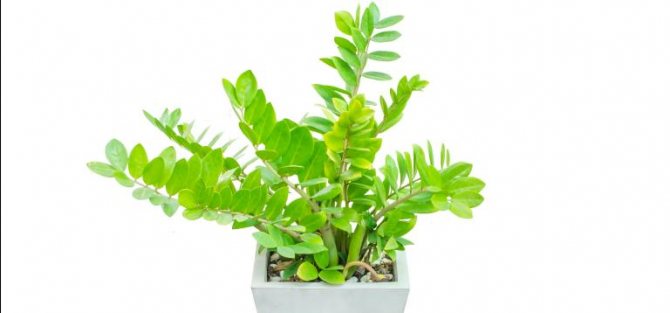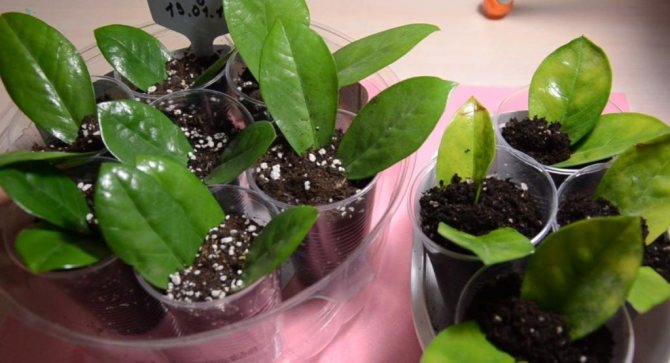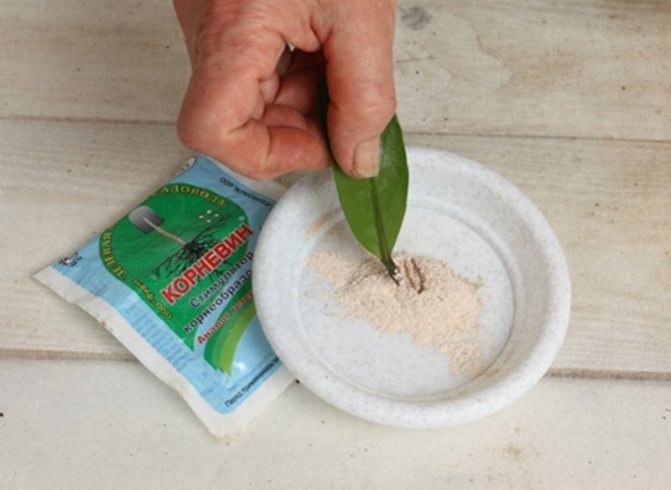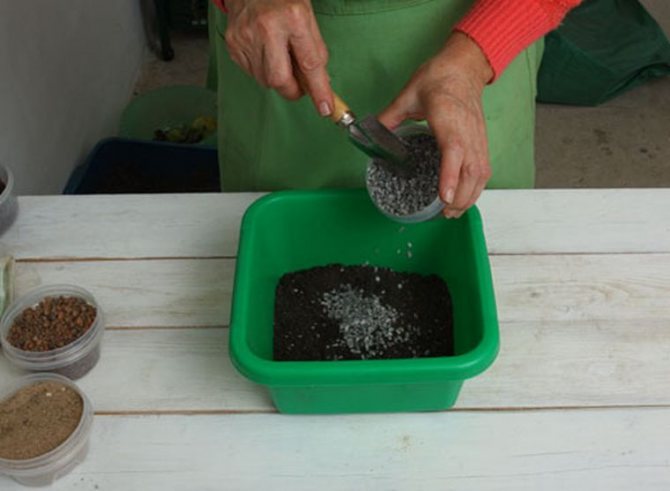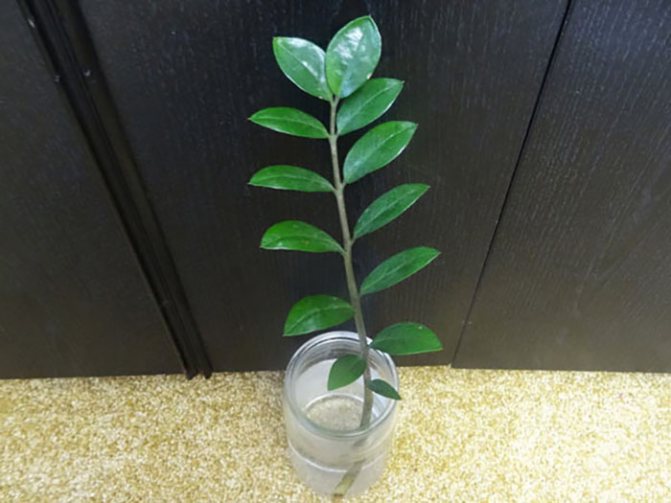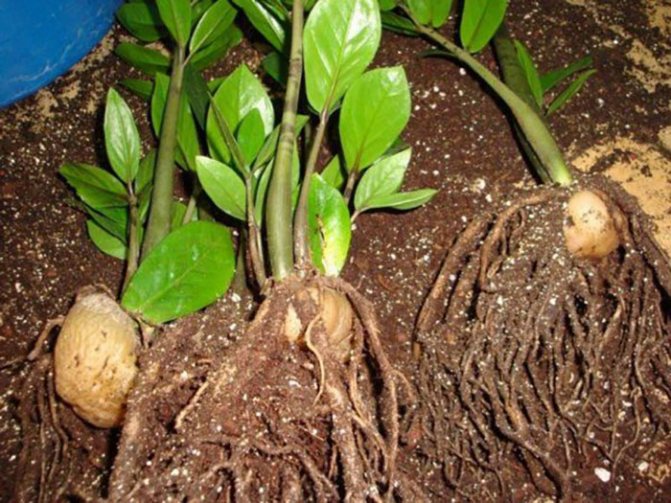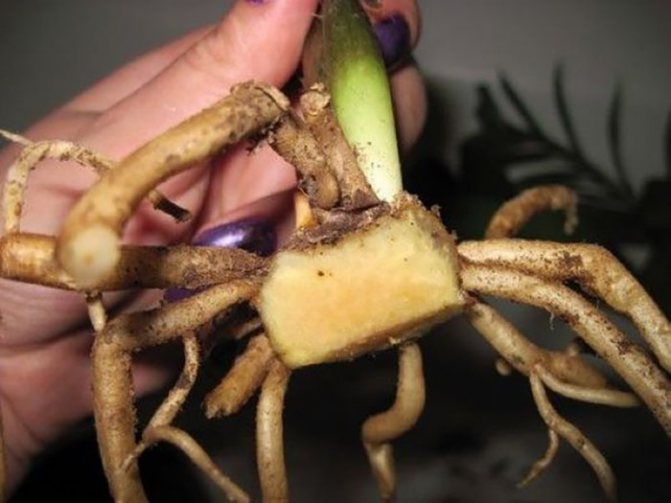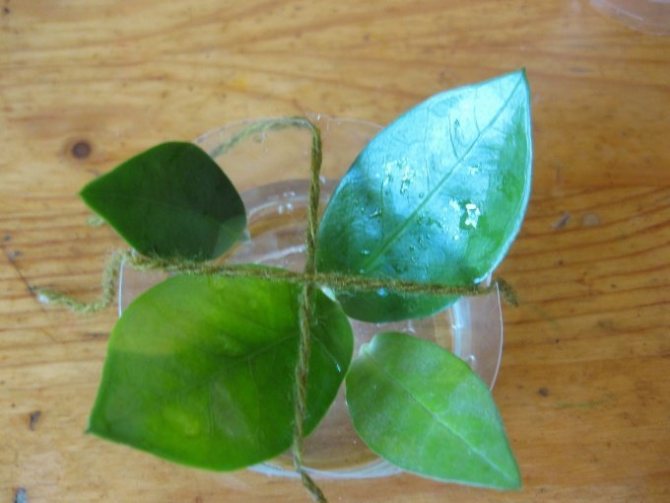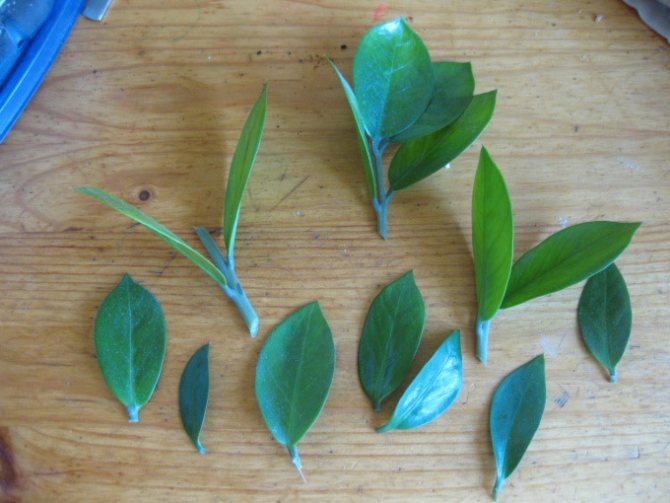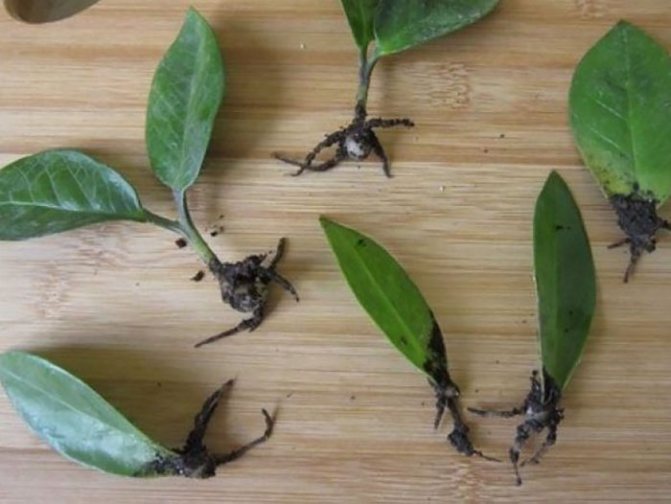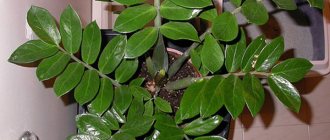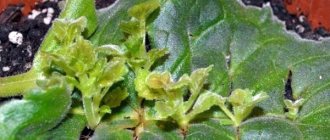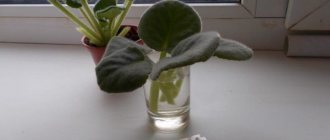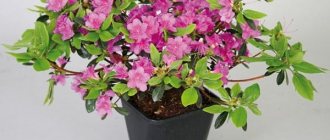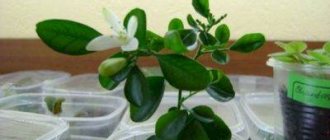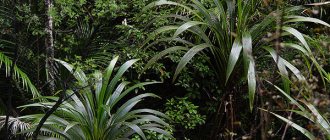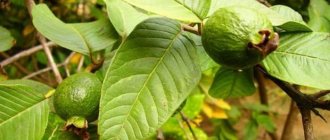This plant is unusual, very beautiful, with dark green leaves. In our country, they began to grow it not so long ago, but this flower has already gained great popularity due to the fact that it is unpretentious and undemanding to care, it feels good in a dimly lit room. Zamioculcas is loved by both professional designers and many flower growers. Since the flower is beautiful and not capricious, many ask: how to propagate zamioculcas at home? This can be done in different ways, this article will cover the main ones.
- Reproduction by dividing the rhizome
- Reproduction of zamiokulkas leaf
- Reproduction of zamiokulkas by cuttings
- The best conditions for rooting
- Practical tips for care and breeding
How does the "Dollar Tree" multiply at home?
The ways to reproduce the "Dollar Tree" are presented below:
By dividing the tuber
Below is the answer to the question of how Zamioculcas reproduces by dividing the tuber: The plant is carefully removed from the pot and the root tubers are examined, they must have buds or growth points, which will subsequently give shoots. The tuber is cut into pieces, sprinkling the slices activated carbon.
Then the parts of the plant with tubers are dried, usually 2-3 hours, no more, and planted in the ground. The primer is ordinary, universal. Expanded clay drainage must be placed at the bottom of the pot. The soil can be mixed with sand, in the proportion: 1 part sand and 2 parts soil... Read more about what kind of soil you need to choose for Zamioculcas and how to process it, read here.
After planting, the plant cannot be watered for 4-5 days, then watering should be done by spraying the top layer of the earth with well-settled water.
By cuttings
Consider how to plant the "Dollar Tree" by cuttings:
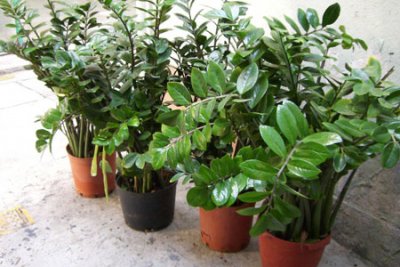
For this method, adult plant leaf, young leaves will not work, they are not sufficiently developed for breeding.
From one adult leaf, you can get a sufficient amount of planting material, plant Zamioculcas at home and share the cuttings with friends.
The sheet is cut into pieces, each piece must have 2 leaves, the top of the leaf is 3 leaves.
After this procedure, the finished cuttings should lie a little in the air, the cut points should be sprinkled with activated carbon (approximately 1 cm of the bottom of the stem) or Kornevin.
Cuttings are planted in ordinary universal soil. It is advisable to create after disembarkation "Greenhouse effect", for this the handle is covered with a glass jar. Watering is done in 3-4 days after planting, the topsoil is sprayed with settled water. Tuber formation usually occurs within 1-2 months, and six months later, new leaves appear.
Sheet and sheet plates
Consider how to grow a "Dollar Tree" from a leaf:
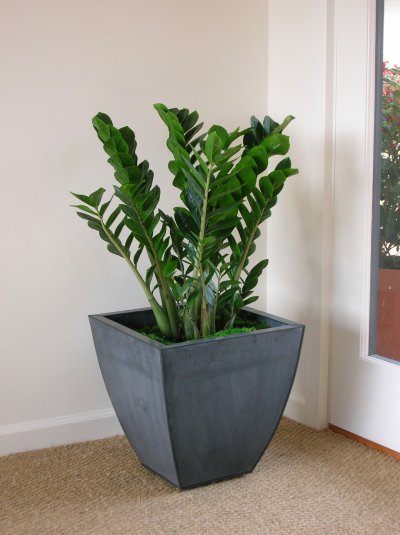

For reproduction in this way, not only an adult leaf is suitable, but also the leaf plates of a plant.
The adult leaf of Zamioculcas is cut, dried (many growers prefer to take only the upper part of the adult leaf with 5-6 leaf plates). The lower part of it is sprinkled with activated carbon or Kornevin (root growth stimulant) and planted in the ground.
The primer is used universal or "For succulents".Watering after planting the leaf is done in 3-4 days by spraying the topsoil with settled water. Tuber formation occurs 2-3 months after planting.
The leaf blades are cut from an adult leaf, the base is dried, sprinkled with activated carbon or Kornevin, and planted in sandy peat soil under a glass jar that creates a greenhouse effect. From time to time, the jar needs to be lifted for ventilation. Watering should be done as usual after planting on the 5th day by spraying. After about a month, small white tubers appear at the base of the leaf.
With a leaf or branch in the water
How to propagate a flower in this way? An adult leaf of a plant can be propagated in this way. Place the leaf in water until a root system is formed. But flower growers prefer methods rooting Zamioculcas in the ground.
Find out more nuances on how to plant an unpretentious Zamioculcas plant with a shoot, an adult leaf with and without roots, as well as a young leaf, find out in this material.
Photo Zamioculcas:
How to plant zamioculcas
As the tubers grow, they interfere with each other, the plant stops growing, withers and may even die.
When a bush grows, it must be planted at least once every 3-4 years.
Technology: the plant is completely removed from the pot, the earth is shaken off, then the roots are washed off with warm water. Examine the tubers, carefully separate them. At the same time, the tubers are left intact and intact.
The smallest tubers are allowed to be collected and planted in one smaller pot. Seating them in separate containers is not very convenient - it takes a lot of containers and consolidated space in the house. In addition, they will have a better chance of surviving, because individually they have not yet accumulated enough nutrients.
Growing
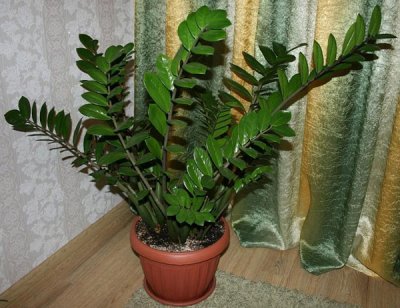

If you purchased Zamioculcas from a flower shop, do not rush to transplant it right away. He must adapt to the new premises. Feed him, he prefers fertilizer for succulents.
Place the flower in a comfortable environment. This plant does not like drafts, cold, like any tropical inhabitant. There should be enough light, but not direct sunlight.
AND do not hurry immediately to your fill get drunk your new tenant, especially after the purchase. It is not worth watering it for at least a week. With proper care of Zamioculkas, you can grow a lush bush with glossy dark green leaves.
You can grow such beauty almost from scratch by yourself from the leaf blades of a flower (this method was described above). To do this, please be patient and your work will be rewarded.
Sprinkle the cut leaves (it is better to cut the leaf plates obliquely) sprinkle with activated carbon, dry and plant in seedling pots in sandy peat soil. You need a little soil pin downso that it fits snugly against the sheet.
To get a faster rooting of the leaves, cover them with a glass jar. After 1-2 months, check the bases of the leaves, they should appear white nodules(some leaves may dry out, but this is not terrible, just the leaf gave all its strength to the formation of the tuber).
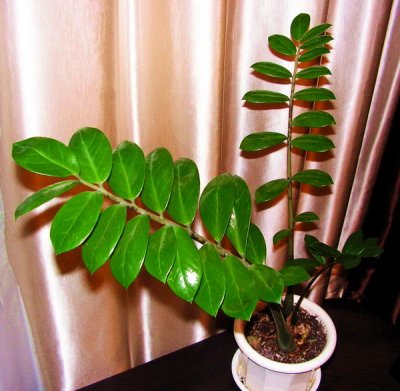

If the nodules have formed, the leaves can be planted in a pot, and several pieces at once, this will allow you to grow a lush plant.
Reproduction of Zamioculcas is a fairly simple process. You just need to remember that the plant toxic, therefore, all breeding and planting procedures must be carried out with gloves. Cultivation of Zamioculcas takes a long time, new shoots and leaves appear every 5-6 months, but with good and proper care, conditions comfortable for the flower, this can happen much more often.
The best conditions for rooting


In order for the zamioculcas to take root as quickly as possible when grown from leaves, tubers, stems or cuttings, it must be planted in special soil. You can buy a suitable substrate at a flower shop; a good option would be a substrate for cacti or violets. Some growers mix the purchased substrate with river sand in equal quantities, or you can plant young zamioculcas in clean sand. River sand is good because it perfectly permeates air and moisture. In order for cuttings, stems or leaves to take root faster, they must be treated with a root stimulant, for example, Kornevin. It is very convenient to plant cuttings or sheets in ordinary disposable cups, which for rapid reproduction must be placed in a warm room, where the air temperature is about 22 degrees. In order for rooting to be successful, diffused light must fall on the zamioculcas; direct rays of the sun must not be allowed to hit. Disposable cups are good because the appearance of roots is visible through them. When the first roots are visible, the soil moisture must be increased.
Useful video
You can find out more useful information about Zamioculkas in the video below:
If you find an error, please select a piece of text and press Ctrl + Enter.
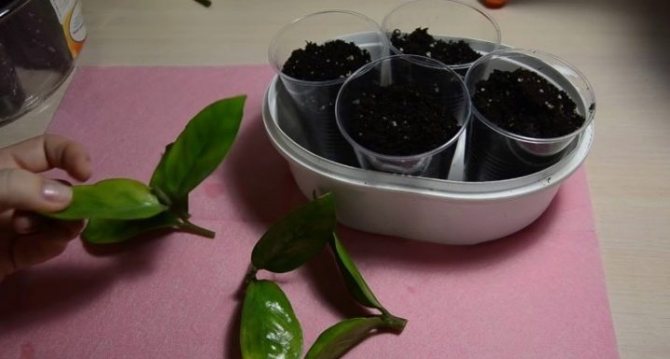

Zamioculcas is a very beautiful and unusual plant covered with many myths and legends. Florists are happy to grow it in winter gardens and on window sills, which is due to the absolute unpretentiousness of the flower and the beautiful juicy green of its leaves. However, not all indoor plant lovers know how to propagate a flower correctly, so the question of breeding it is relevant for many of them.
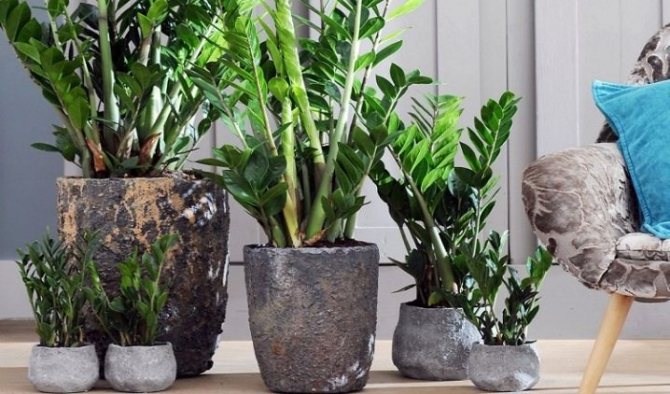

Breeding conditions
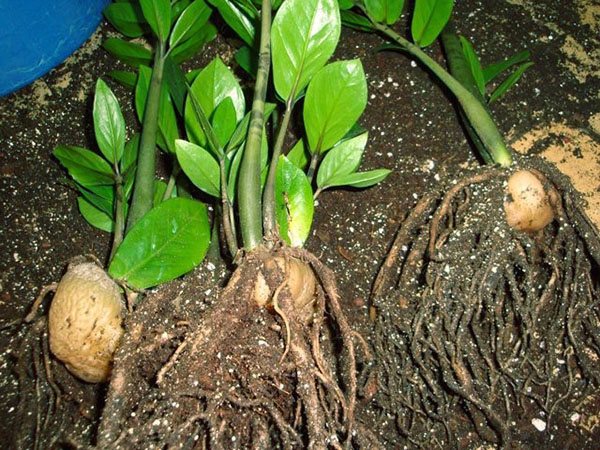

Caring for zamiokulkas at home includes reproduction with periodic transplantation into a new container. In this case, the process of dividing the tubers is gentle. They need to be carefully planted in prepared bowls with a good drainage layer and covered on top until new leaves begin to form.
All parts of the plant are poisonous. When working, you need to use gloves, and make sure that the pieces of the plant are not eaten by animals or children.
Other ways to get new plants are by rooting cuttings, leaves, or cut tubers. It must be borne in mind that any breeding method is long-term. Therefore, if germination takes place in water, then it should not turn sour. Germination substrate does not contain humus, sterile, steamed.
In the process of rooting, a nodule is formed due to the nutrients of the leaf or cutting. Therefore, by the time the first young leaf appears, the old part turns yellow and wrinkles. This is normal.
Rooting takes place in warmth and light. So that the ground part does not evaporate moisture, a cap is created over the plant, sometimes the new plant is ventilated. Watered very sparingly, so that the water wets the ground only at the sides of the glass.
A little about the form
Zamioculcas (lat.Zamioculcas) is one of the most famous representatives of the Aroid family among the general public and is considered monotypic. This genus has only one species, which is called zamiokulkas zamielistny (lat.zamiifolia) and is a succulent, which is generally not typical for the Aroids. Southeast Africa is considered the homeland of the plant, where the flower covers large areas with its lush greenery and, when a prolonged drought sets in, sheds its leaves, thus reducing the area of moisture evaporation. Along with the official botanical name, the flower also has several folk names.
In our country, it is better known as the "dollar tree", although in other countries it is called both "aroid palm" and "Zanzibar pearl". According to Chinese beliefs, the plant is considered one of the symbols of the New Year and promises to its owner an improvement in material well-being. Fans of decorative flowers love zamiokulkas for its unusual complex-pinnate leaves - very thin and at the same time tough to the touch, attracting attention with an even gloss and rich dark green color. The leaf blade has an interesting structure and consists of 8–12 feathers, which is also atypical for Aroids. If you look from afar, the flower can be easily mistaken for artificial: its leaves are so regular and one-dimensional.
What does zamioculcas look like
Zamioculcas (Zamioculcas) is a genus belonging to the Aroid family (Aroideae). From the point of view of most botanists, it is monotypic, having a single representative - zamiifolia or loddigesii. Others distinguish between two and four varieties.
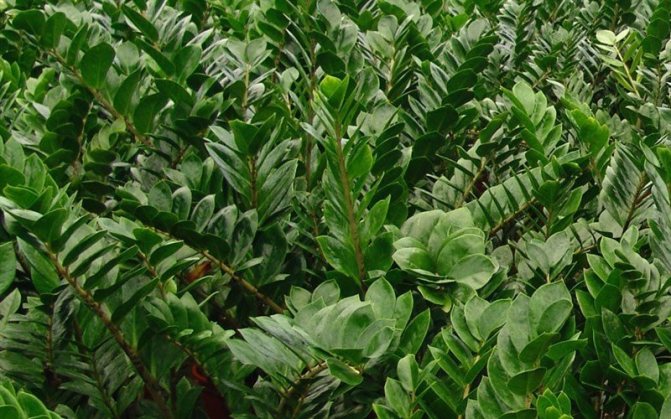

In nature, zamioculcas forms solid carpets of bright green leaves
The homeland of the plant is the plateaus in the south and southeast of Africa. The conditions, by human standards, are extreme there. But the plant has successfully adapted to them. Like most local representatives of the flora, zamiokulkas is a succulent, which is, in principle, atypical for the Aroids.
During the short rainy season, it accumulates moisture in its thick, fleshy leaf stalks, stems and underground tubers. This "NZ" helps him survive a prolonged drought. If the plant is doing really badly, it sheds the leaf plates, leaving only the petioles and veins (axis-rachis). This helps to reduce the evaporation area.
The flower owes its name to the fact that its leaves are very similar to the leaves of another African plant - zamia (in the literal translation "zamioculcas" - "zamie-like"). The final name was not immediately approved. The first version ("Caladium is the most charming") belonged to the famous British lover of exotic flora, Konrad Loddiges. He first described the plant in 1829, but, not being an expert in botany, he mistakenly included it in the genus Caladium, although he was not mistaken with the Aroid family.
The inaccuracy was corrected only in 1856 by an even more famous botanist from Austria, Heinrich Wilhelm Schott. He singled out the plant in a separate genus, "christened" Zamiokulkas and named it in honor of the discoverer. Since the beginning of the 20th century, an intermediate version has been established in the literature - zamioculcas zamielistny.
In addition to the official name, the plant quickly acquired many nicknames - "dollar tree", "eternal" or "aroid palm", "Zanzibar pearl". Zamioculcas was especially loved in China. There, it is considered a symbol of the New Year, and the Feng Shui teachings associate the well-being of the owner with it.
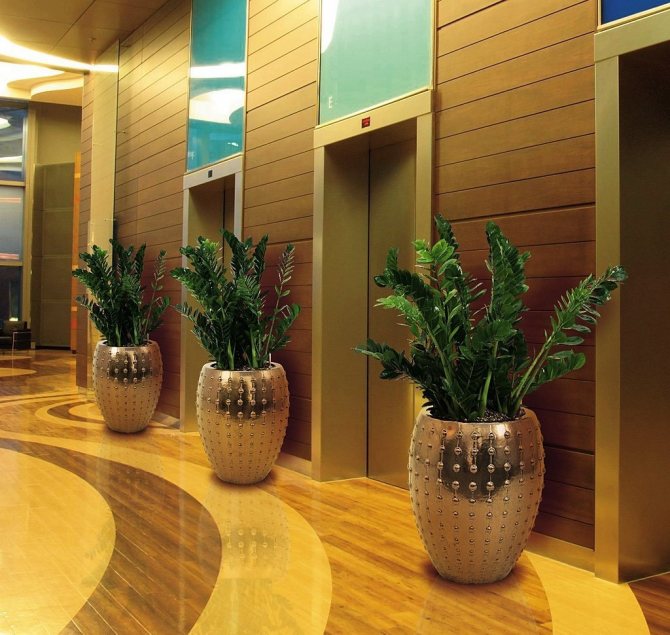

In China, where the teaching of Feng Shui is especially popular, zamioculcas is often used to decorate the interior of office premises, thus attracting good luck in business.
Indoor plant lovers appreciate it for the beauty of its leaves. They are glossy, dark green, thin, but rather stiff to the touch, complex-pinnate in shape. The leaf blade is dissected into 8–12 separate "feathers" - this is also a unique phenomenon for the Aroids. Small blurry spots of inky violet color fit into the norm. From a distance, the flower generally seems artificial, because the leaves are very even, one-dimensional.
A complex-shaped zamioculcas leaf is not a separate leaf, but a whole "plate"
The growth rate of zamioculcas does not differ, but at home it is rather an advantage. It often sheds old leaves faster than forms new ones. The maximum height in captivity is about 1 m.
Zamioculcas has a developed root system. It consists of powerful tubers and thick worm-like roots extending from them. If the plant is not transplanted for a long time, a cramped pot that prevents further growth may even crack under their pressure.
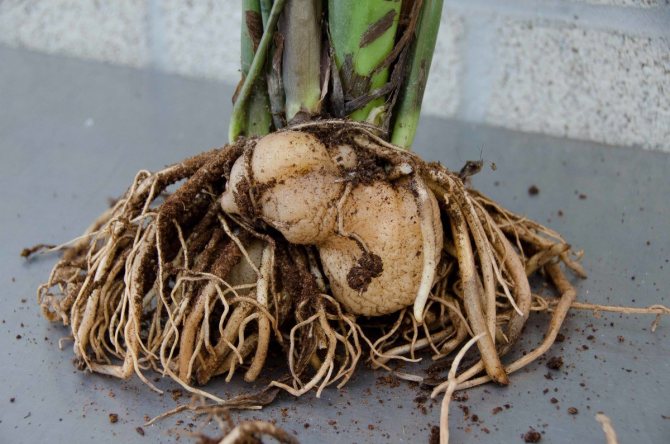

The root system of zamiokulkas is very developed, it is in the tubers that the plant stores the main supply of moisture and nutrients
The flowering of zamiokulkas not only at home, but also in nature is an extremely rare phenomenon. It can only be expected from mature, mature plants. Then the ear is covered with large berries, each containing one seed.
Zamiokulkas has an alternative, almost unique way of reproduction. The base of leaves that have fallen to the ground gradually thickens, turning into a tuber, which then forms roots and goes underground, releasing new shoots.
But you should not be upset about the lack of flowering. The spectacle is definitely not outstanding. Small yellowish-cream flowers are collected in a thick ear, tightly wrapped in a pale green or light beige bedspread. The inflorescence is located in the lower part of the plant, in the axil of one of the leaves, therefore it is almost imperceptible. FROMThe seeds at home are not tied in principle, even if you "help" the flower by artificially pollinating it. According to the experience of most experienced indoor plant lovers, flowering often means the imminent death of this specimen.
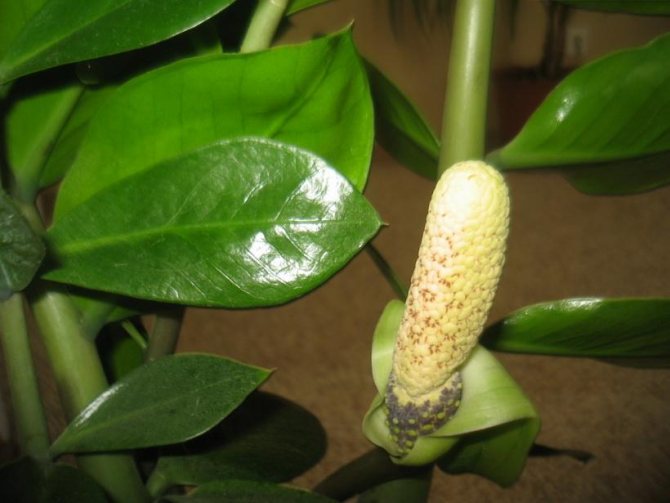

The flowering of zamiokulkas is definitely not the most attractive sight in the world.
Video: appearance and other characteristic features of zamiokulkas
Breeding rules
Reproduction of zamiokulkas at home is a long and painstaking process, but subject to a number of rules and creating comfortable conditions, the success of the event is almost guaranteed.
- Compliance with personal precautions. The fact is that zamioculcas, like all representatives of the Aroid family, is a poisonous flower. Its leaves contain a rather caustic milky juice, which, if it gets on the skin and mucous membranes, can cause severe irritation, redness and burns, and if it gets into the stomach, it can even provoke a serious upset. Therefore, before planting or planting a flower, it is imperative to wear protective gloves.
- Choosing a suitable soil. To do this, you can take a ready-made substrate for cacti and succulents, mixed in equal proportions with leaf humus, sand and peat. It will be useful to add vermiculite, perlite or crushed pumice to this mixture, as well as red brick chips or pieces of charcoal. Any of these components can be included in the prepared substrate, but its share should not exceed 5–7%. Such substances significantly improve the aeration properties of the soil and ensure the flow of oxygen to the root system, which does not allow the roots to rot, and also contributes to the timely outflow and evaporation of excess moisture.
- Drainage arrangement. For these purposes, expanded clay or medium river pebbles are well suited, the layer of which in the pot should not be less than 3-4 cm.
- Providing warmth and bright diffused lighting. Direct ultraviolet rays can burn the leaf blades and spoil the decorative appearance of the plant. To create the optimal temperature regime, the containers are placed with young shoots in homemade mini-greenhouses, using glass caps or plastic wrap for this.
- The optimal time for reproduction of zamiokulkas is the beginning of spring. It is in the spring months that the active vegetation of plants falls, and therefore, by the fall, the young shoot will have time to accumulate the necessary amount of nutrients and calmly leave for the winter.
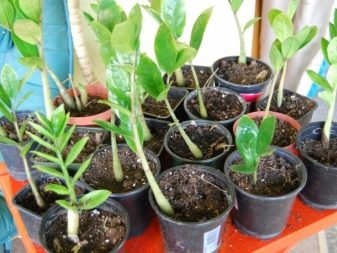

Choosing a soil and a pot
Zamioculcas stores moisture and nutrients in its tubers and roots. So he needs air and moisture permeable soil - this is the main condition for growing a flower. Water plays an insignificant role in its formation. But the quality of the soil and the presence of nutrients in it are extremely important for the "dollar tree".
A dense loamy or clayey substrate is not suitable for zamiokulkas and can even harm.Indeed, with a minimal excess of moisture, its roots quickly begin to rot. It is best to grow the "dollar tree" in soil intended for succulents and cacti.
Well, the best option would be to prepare the mixture yourself, which will contain the optimal amount of nutrients for zamiokulkas. To do this, you need to mix in equal proportions peat, sand and deciduous soil. You can additionally add vermiculite or charcoal to the soil - these substances feed the roots and absorb excess moisture. Their volume should not exceed 7% of the total amount of soil. At the bottom of the flowerpot, be sure to put drainage in the form of expanded clay or pebbles. The layer height should be approximately 3-4 cm.
Ceramic and plastic pots are great for growing the dollar tree. The container should be quite roomy, but not very deep. And at its bottom there must be drainage holes that prevent stagnation of water.
The ways
When propagating zamioculcas at home, they use methods such as cuttings, dividing the bush, rooting the leaf blade, as well as tuberous and seed methods.
Cuttings
Cutting is the most common and effective way to propagate a flower. It is worth considering this method step by step.
- To begin with, choose a strong and healthy shoot, from which a small shoot with two or three leaves is cut off. The top of the mother plant over 5 years of age is ideal. In addition to the crown, you can take any other part of the bush, the main thing is that the base of the branch from which the cutting is cut should be semi-lignified. It is not recommended to take a plant recently purchased from a store as a parent. This is due to the fact that suppliers often treat the bushes with growth stimulants and other chemicals. The action of such drugs significantly reduces the percentage of rooting of cuttings and makes the reproduction process very difficult. In order for such a plant to participate in reproduction, at least 1 year must pass.
- Cut the stalk from the flower with a well-sharpened knife, which should be disinfected before the procedure. After cutting, the stalk is placed on a clean napkin and the wound is allowed to dry out a little. After 2–3 hours, the cutting is placed in the prepared soil mixture or placed in water, after having mixed 2–4 tablets of activated carbon or several crystals of potassium permanganate in it. Before planting in the substrate, it is recommended to treat the cut with a powdery biostimulant, and then deepen the process by 2–3 cm.
- Next comes the most important part of the event - creating greenhouse conditions for escape. To do this, the seedling is provided with lower heating, a humidity of at least 70% and a temperature of at least +25 degrees are created. The first watering is allowed no earlier than the third day after planting. The soil is moistened as it dries up, using a weak Kornevin solution. Young roots usually appear after 2 weeks, from that moment the watering intensity is slightly increased. The formation of young tubers occurs after 7–8 weeks and is a signal to transplant the plant to a permanent place.
- The first leaves of a young zamiokulkas appear in a tightly twisted and covered with a red film, but this does not happen soon, but 6–8 months after planting. Experienced experts recommend grafting several shoots at once. This is due to the very low survival rate of shoots, of which not all can take root. As for water rooting, here you need to be very careful and try not to miss the onset of decay, which often begins in succulents from excess water.
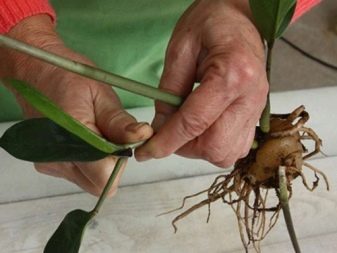

By dividing the bush
Propagating zamioculcas in this way is very convenient when transplanting a plant. It is worth performing a few simple steps.
- The bush is carefully removed from the pot and the root processes are thoroughly cleaned from the substrate. Then the roots are carefully untangled, trying not to cause damage to them, and the bush is divided into two or more parts, focusing not on the presence of adult branches, but exclusively on the growth points. So, at least one such point must be present on each detached shoot.
- Then both plants are left for a short time in the fresh air and sprinkle the damaged areas of the roots with crushed charcoal. Planting of independent shoots is carried out in a prepared substrate with the obligatory formation of a drainage layer in the pot.
The soil mixture should be insufficiently poured to the edge of the pot by 2–3 cm, which in the future will save from pushing the soil out with a strong growth of roots.
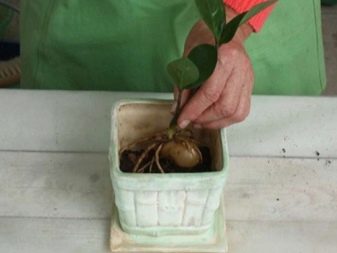

Sheet
You can also grow a new flower from a leaf. It is worth doing the following:
- take a sharp disinfected knife and cut off several large healthy leaves, preferably together with the stem;
- then the leaves are left in the air for 2 hours, after which the cut points are treated with "Zircon" or "Kornevin";
- further, the leaves are planted in a substrate and covered with glass or film;
- cultivation is carried out by analogy with the cultivation of cuttings, regularly moistening the soil and airing the mini-greenhouse.
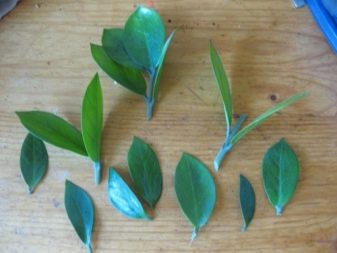

A significant disadvantage of the leaf propagation method is the fact that it will not be possible to root and grow a young plant in a short time. It usually takes at least six months to form an independent plant. With this method of reproduction, the leaf gives rise to the formation of a tuber, from which root processes subsequently grow. At the same time, the leaf blade dries up, and the strengthened tuber gives new shoots. When the first leaf appears, the flower is transplanted into a pot with a diameter of 7-10 cm and transferred to the general mode of care.
The growth of green mass occurs very slowly, for example, in the first year, no more than 3 leaves appear on a young plant.
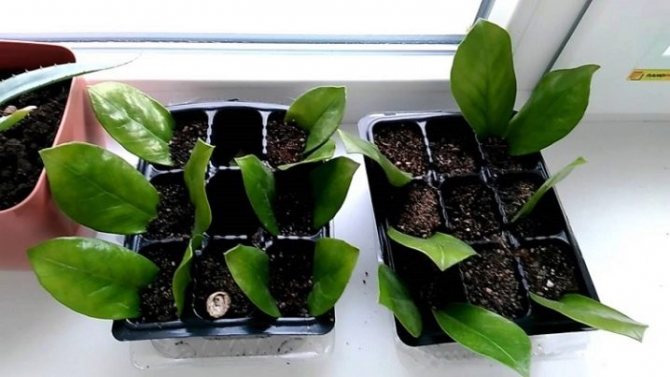

Tubers
Planting zamioculcas in this way is quite risky. This is due to the fact that the division of the tuber often provokes the death of the entire plant. Therefore, for tuber reproduction, plants are chosen at least 50 cm in height, with a well-developed horse system and aboveground part. The optimal time for propagation of tubers is from the end of April to September. The breeding procedure is as follows:
- the flower is taken out of the pot and the root system is cleaned of the earth;
- further, a tuber is dissected with a sharp knife in such a way that on each of its parts there are several roots and at least one growth point;
- the cut points are sprinkled with a thick layer of crushed charcoal and left in the open air for a day, which helps to dry the cut tuber a little and reduces the risk of rotting;
- the next day, the bushes are planted in nutritious soil and placed in a warm place, away from drafts and direct sunlight;
- fertilization at the stage of rooting of the bush is completely excluded, and instead of watering, spraying is used;
- fertilization of plants with mineral fertilizers begins no earlier than 4–6 weeks after planting.
Pruning and replanting
The plant is sheared if they want to give the bush a certain shape or dense crown.
Damaged or dried branches should also be removed. Especially if the disease is the cause.
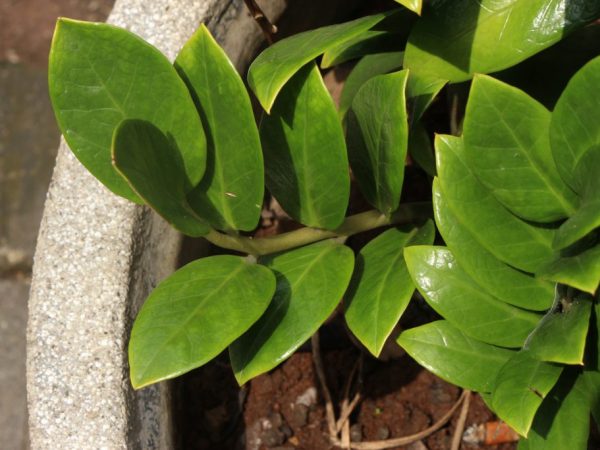

Transplanting time depends on the age of the plant.
A young zamioculcas is transplanted once a year, an adult - once every 2-3 years.
Technology:
- The pot is chosen 2-3 cm larger in diameter than the previous one.
- A large drainage (clay shards, expanded clay) is laid out on the bottom. Then a finer baking powder (vermiculite, gravel). The next layer is soil mixed with foam and perlite.
- The plant is removed from the pot and simply transferred into a new container as a whole. At the same time, the roots are not shaken off or separated.
Such a transplant is the least traumatic for a flower.
Follow-up care
Caring for a young zamiokulkas is quite simple. This requires providing the plant with comfortable conditions of temperature, lighting and humidity, as well as watering, pruning, replanting and feeding the flower on time.
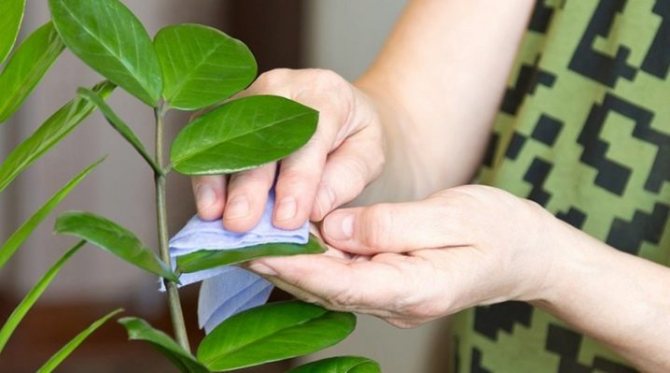

Watering
Watering the flower should be done only after the substrate is completely dry. This is due to the fact that the plant is a succulent and stores a sufficient amount of water in its tissues. From excessive moisture, the root system of the plant can begin to rot, which will cause the death of the flower. In the hot season, 2 waterings per month are enough for zamiokulkas, provided the soil is completely dry. In addition to watering, the plant is very fond of a warm shower.
However, this procedure should be performed not so often, and the earthen substrate must be covered with a film during the procedure.
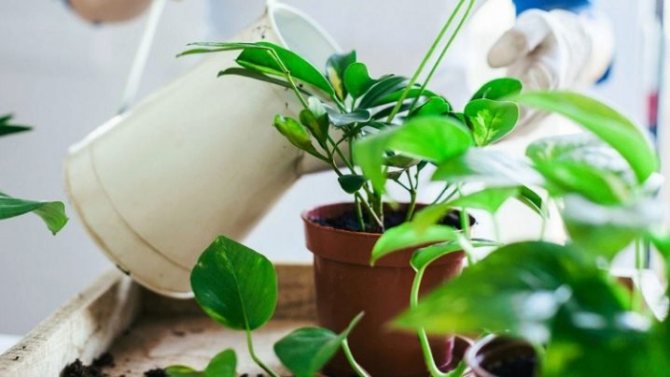

Lighting
Despite its African origin, Zamioculcas does not like direct sunlight. It is better to provide the plant with bright, but at the same time, diffused light by erecting an artificial screen for this or by placing the flower in partial shade of higher species. However, the lack of ultraviolet radiation affects the plant rather badly. The leaves of the flower become faded and lose their former decorative effect.
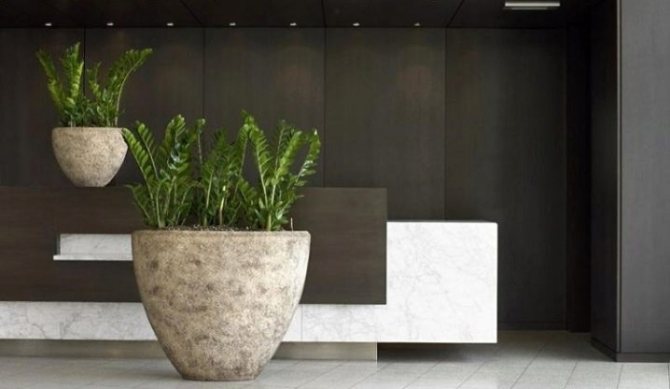

Top dressing
It is better to feed young zamioculcas by foliar method. Spraying is carried out no more than once every 20 days, using any complex of mineral fertilizers for decorative leafy plants or succulents. As a result of this treatment, the leaves become beautiful and shiny, and their petioles become noticeably denser.
In the autumn-winter period, when the plant is dormant, the application of fertilizing is stopped, resumed only in mid-April.
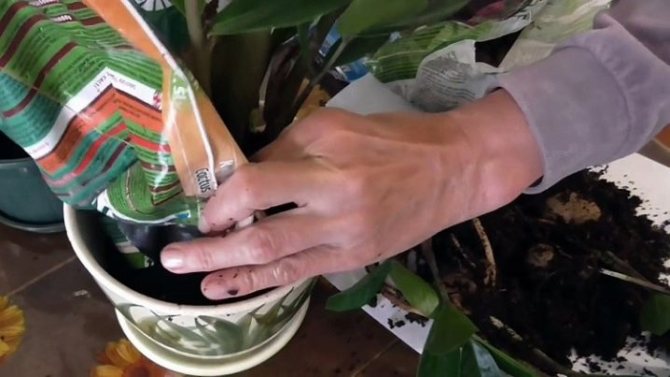

Temperature and humidity
The plant is well adapted to home conditions and feels normal at a normal room temperature of + 22– + 25 degrees. A prerequisite is the absence of sudden temperature changes and drafts, from which it can throw off foliage and die.
As for humidity, the grown flower feels great at 50-60% and does not need additional moisture in the room.


Pruning and replanting
Pruning in its full sense is not a mandatory event for a flower. However, dry peduncles and infected shoots must be removed in a timely manner. It is recommended to transplant the plant into a wider pot every year, using the technique of transferring a bush while preserving an earthen coma.
After the procedure, the flower is left alone, and the first watering is carried out no earlier than 3 days later.
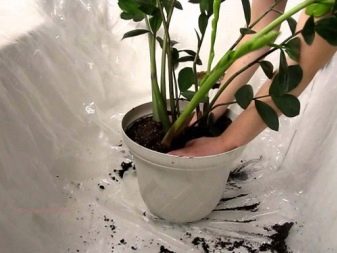

Young plant care
At the first stage of growth, immediately after transplantation, the zamioculcas will not grow. He needs time to get used to the new soil. You can help the plant by creating favorable conditions. These are temperature conditions, light and watering. Immediately after breeding, zamioculcas are not fed - the soil contains all the nutrients.
Temperature
The optimum temperature in summer during the active growing season will be 22 - 25 degrees. Humidity is moderate. In preparation for wintering in the fall, the plant is transferred to a cool room with a temperature of 16 - 18 degrees. The flower is not afraid of drafts, but it is necessary to ventilate the room often - every day.
Lighting
Thick, leathery leaves can burn if the plant is exposed to the sun without gradual getting used to. The most suitable place for a zamiokulkas is a southeast window or a south one behind a curtain, blinds. On the north side, the flower will feel worse due to lack of light.
Watering
Watering is necessary on demand: if the soil is dry, add water, draining the rest of their sump. It is necessary that there is air between the roots and the bottom of the pot, then rotting does not threaten the roots. Water carefully in winter if the room is cool.In this case, it is better to wait until the soil is completely dry and then water.
In summer, the soil must not completely dry out - this leads to yellowing of the foliage and its fall. Also, the flower will grow poorly without moisture, consuming it from the tuberous reserves. It is dangerous to propagate a weakened plant - it may not tolerate the procedure.
Top dressing
Fertilizers can be applied from the beginning of the growing season - in the spring. Water with nutrient solution twice a month until autumn. Minerals are especially needed for old plants, which are rarely transplanted, since they choose all nutrition from the soil for growth.
In winter, zimioculcas are not fed - this can cause harm. Fertilizers are bought for succulents or cacti. The plant absorbs nutrients better in sunny weather. If it is rainy and cloudy, it is better to transfer watering.
Formation
As it grows, old leaves naturally dry out. So that they do not pull nutrients from young branches, the old ones are cut off. You also need to remove yellowed leaves - they contain fungal spores that can infect the entire bush.
To prevent long branches from breaking, it is recommended to equip a support and fix the flower with plastic rods. Zamioculcas grows symmetrically with respect to old branches. He is able to form his own crown, so trimming green complex sheets is not needed. If it is carried out, then you can root the trimmings for breeding new plants.
Transfer
A transplant is needed for young plants, while their root system grows and the green mass grows. When the dollar tree reaches its maximum and it is necessary to slow down its growth, it is not transplanted, since the root receives an incentive to grow, and leaves trail behind it.
The signal to transplant - the roots fall out from below through the drainage holes.
Possible problems
The most common problem in the reproduction and cultivation of zamiokulkas is the defeat of the root system by rot. In most cases, this is due to errors in agricultural technology, in particular, due to a violation of the humidity and temperature regime. If the soil in the pot does not have time to dry, and the room is much less than +20 degrees, then it is almost impossible to avoid the appearance of fungal infections. To prevent this kind of trouble, it is recommended to regularly examine the flower for signs of decay.
And if black-brown weeping spots are found on the stem and leaves of the plant, immediately take measures to save the flower.
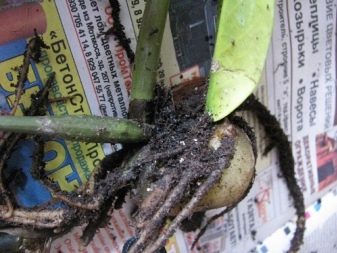

For this, with a sharp disinfected knife, leaves and shoots affected by the decay process are cut off, the wounds are treated with crushed chalk, activated carbon or colloidal sulfur. Further, the plant is removed from the pot and its tubers are placed for half an hour in a weak solution of potassium permanganate or 1% composition of Bordeaux liquid. While the flower dries up after disinfecting the roots, and this takes at least 2 hours, they begin to sterilize the pot and prepare a new substrate. To prevent fungal infections, several granules of the preparations "Glyocladin" and "Trichodermin" are added to the soil, after which the disinfected drainage is placed on the bottom of the pot and a new soil mixture is poured.
Within 3 months after planting, not water is used for irrigating zamiokulkas, but a 0.5% solution of "Alirin-B", "Fundazola" or "Previkura". Moreover, watering is performed in a very metered manner. In this case, light underfilling will be much more useful than abundant soil moisture.


When providing emergency assistance, it is necessary to take into account that the plant can be saved only at the initial stage of the disease. If putrefactive processes have affected most of the root system and aerial shoots, then all measures to save the flower are meaningless and will not bring results. Signs of irreversible processes are too easy separation of leaves and shoots, mold growth and an unpleasant putrefactive smell from the bush.In this case, the plant and the earthen mixture must be thrown away urgently, and the pot must be washed well with laundry soap and sterilized.
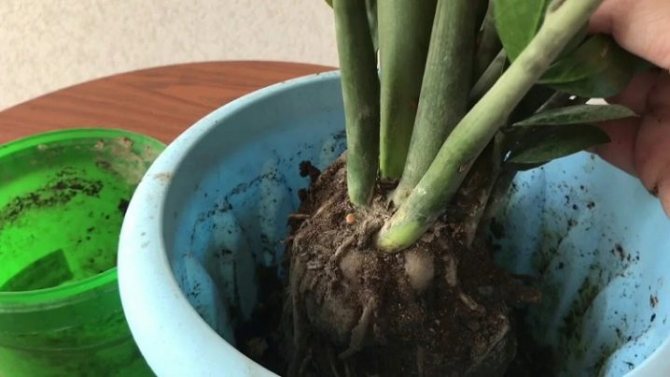

You can find out the secrets of Zamioculcas transplant by watching the video below.
The dollar tree or Zamioculcas is an amazing houseplant that growers appreciate for its impressive appearance and ease of growing. The flower is widely used for the decoration of residential premises, as well as offices, conservatories and greenhouses. Recently, they began to breed it not only for the sake of decoration, but also to attract wealth.
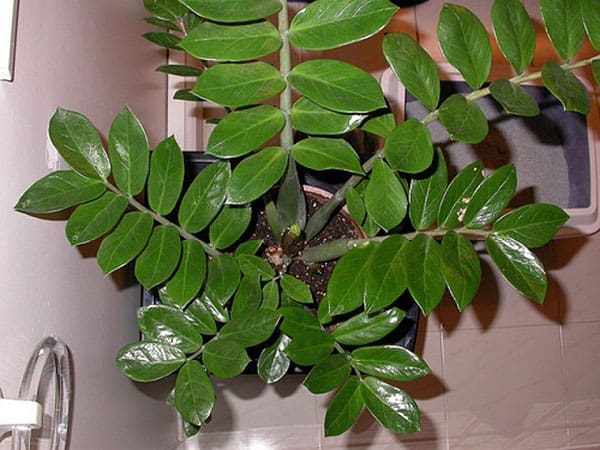

According to the teachings of Feng Shui, the plant attracts monetary energy into the house and not only it. Zamioculcas is also able to bring happiness, harmony, love, mutual understanding and prosperity to the family. Many of us do not know what kind of plant it is, how to grow it, propagate and transplant it. This is what this article will be about.
Reproduction in water
This method consists in placing a twig or leaf of an adult specimen in water. There, the plant will form a new root system and begin to develop.
Here, as you may have guessed, everything is extremely simple. The only secret is to treat the cut site with a root growth stimulant. To do this, you can take "Zircon", "Kornevin" or "Heteroauxin".
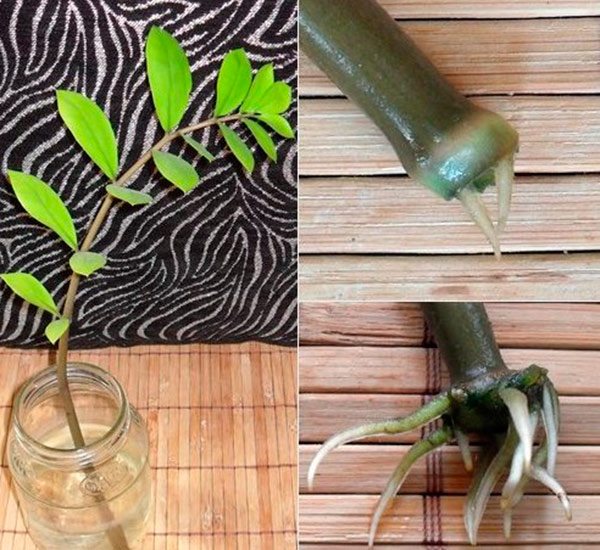

These funds can significantly speed up the process of rooting of the shoot. If you believe gardeners, it is best to plant the plant in the ground.
The origin of Zamioculcas
The dollar tree belongs to the Aroid family. It comes from the African continent, where it grows in tropical forests. This flower was first mentioned in 1828. It was described by the famous botanist and collector Konrad Lodijes. Zamioculcas gained fame quite recently, just a few decades ago. At the beginning of the 21st century, a single specimen of the plant was obtained, suitable for growing as a room culture.
The dollar tree comes from the island of Madagascar. It is there that it grows in its natural environment. In indoor conditions, only one type of tree grows - Zamioculcas zamielistny.
Plant features
Zamioculcas is an evergreen herb, native to tropical Africa. Dense glossy leaves of dark green color have the shape of a long feather, collected from individual leaf blades on a dense base.
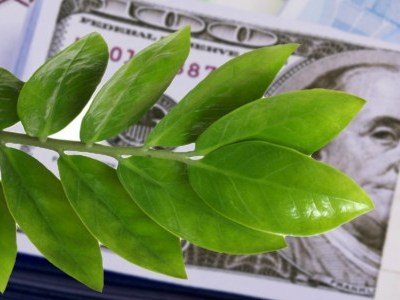

Between themselves, the leaves are collected in a dense rosette and form a lush fan about 60 cm high.
The underground part consists of tubers and thick, fleshy roots.
Zamioculcas blooms rarely even under ideal conditions., the appearance of the inflorescences is not too expressive.
The flowers have an unusual shape, which brought him the fame of a plant - muzhegon. Because of this, the harmless succulent is popularly called the flower of celibacy.
But much more often they call it the dollar tree, which attracts monetary luck and improves the well-being of its owner. Zamioculcas can often be found in the interior of offices and bank branches.
Most likely, the real reason for the popularity of zamiokulkas is that it is surprisingly unpretentious. Caring for him at home is very simple. The flower prefers a bright place, protected from direct sunlight.
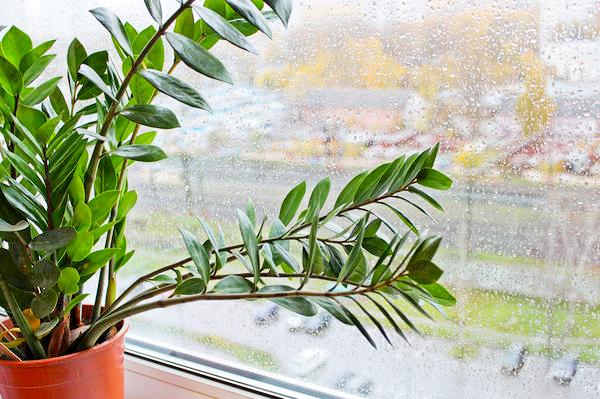

But it easily tolerates partial blackout combined with dry air, which makes it ideal for keeping in city apartments. Watering the succulent is necessary rarely and in moderation, making sure that there is no stagnation of water in the pot.
Interesting Facts
It is believed that the flower brings success and prosperity to the house. But you cannot buy a plant yourself - it must be presented as a gift or grown by your own hands. The tree should be presented by a person who is prosperous in all respects, otherwise Zamioculcas will not be beneficial. In order for the plant to work, a few coins must be given to the person who gave it for the donated flower.
There is a sign that if Zamioculcas is decorated with dollar bills of different denominations for the New Year, then the year will become profitable, and it is also possible that the owner of the flower will go on a trip abroad.
The plant is very sensitive to the positive energy of the owner, and if he respects the flower and cares for it anxiously, then the dollar tree will reciprocate and become a reliable talisman that brings good luck.
Description
There is an opinion among the people that zamioculcas brings not only comfort, but also material well-being to its owners. It is for this that he was nicknamed the "dollar tree".
This plant resembles a rosette formed from long dark green leaves with a glossy surface. In the center of the leaves are fleshy miniature leaves with pointed tips. True, adult specimens look much more impressive: their height can reach one and a half meters.
If you provide a favorable environment for Zamiokulkas, it will delight you with its abundant unusual flowering every season. Although gardeners love him not at all for flowers, but for luxurious large leaves with a decorative pattern. So, even those who do not have it blooming get real pleasure from the presence of the "dollar tree" in the house.
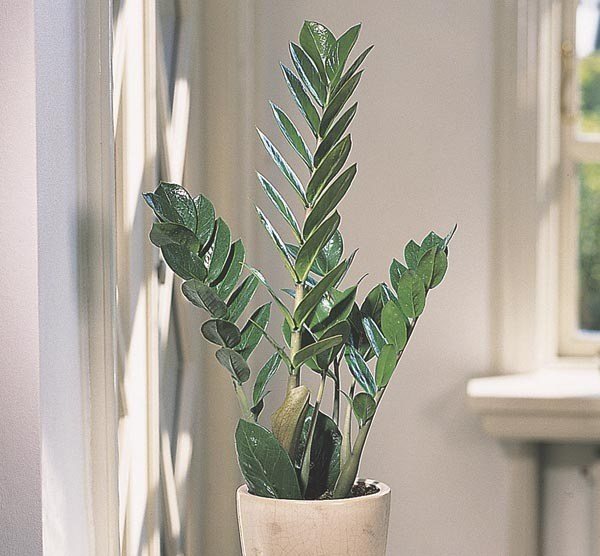

The natural habitat of Zamiokulkas is arid mountain plateaus. So the plant can withstand even prolonged droughts thanks to its ability to accumulate precious moisture in its succulent, fleshy leaves. That is why the tree does not particularly like abundant, regular watering. And it is indifferent to lighting, developing equally well in the shade and in the light.
People who already have this plant are happy to acquire new copies of it. After all, it is easy to care for and it fits perfectly into any interior. If you, too, are among the fans of zamiokulkas and have already decided to acquire a couple more beautiful bushes, do not rush to go to the store. After all, it is much more pleasant to grow a "dollar tree" with your own hands, especially since you will need a minimum of time and a little effort for this.
Description of the plant
The flower has no stem. The leaves of the plant grow directly from the tuber. The leaves are located on false stems, thick and fleshy, which contain a supply of moisture. The flower grows very slowly. It has dark green glossy leaves of regular shape. Plant height - about 50 cm.An adult dollar tree over 5 years old can bloom.
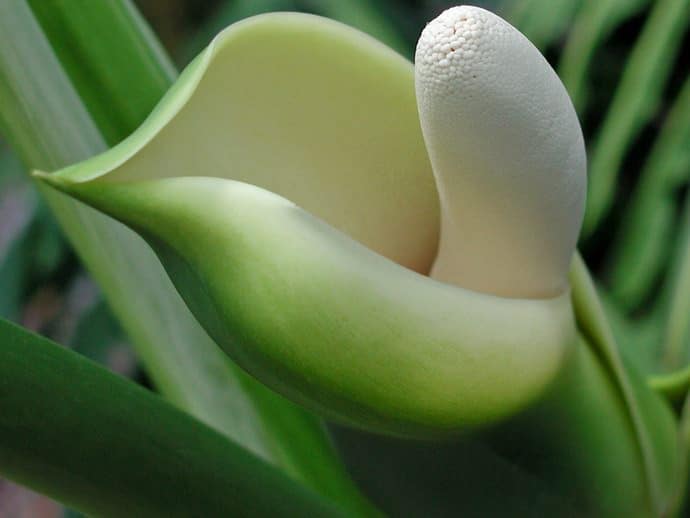

The flower is a thick, short ear of white color, around which a white veil is located. By itself, it has no value, since the seeds rarely ripen in indoor conditions, so the flowers are usually removed.
Reproduction of zamiokulkas by cuttings and leaves
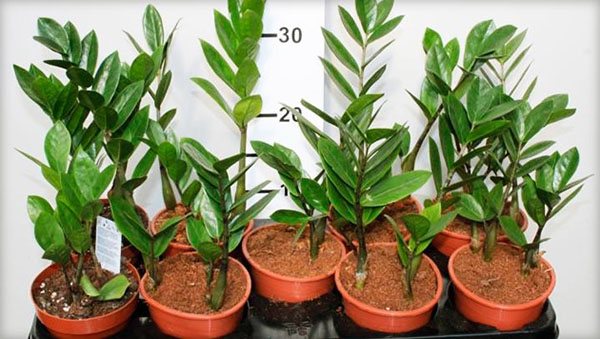

It is easier to propagate zamiokulkas with a leaf or a cutting, as practice shows. To do this, you do not need to injure the plant with a transplant. A sharp knife can be used to separate one pinnately dissected stem. If you cut it into segments that have growth buds, then these are cuttings. The upper stalk may contain many blades. And the higher the cutting, the more successful the rooting.
At home, zamioculcas multiplies both in water and in a special substrate. In this case, it is important that the tip of the petiole does not rot. For this, activated carbon or a fungicide is added to the water, which suppress the decay process. It takes a month or more before roots appear. Rooting can also be done in clean wet sand or sphagnum moss.
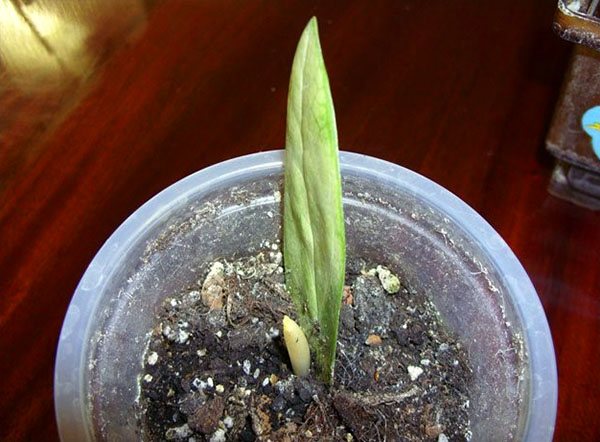

Leaf blades for propagation are cut with a sterile instrument with a piece of the stem. They can root in water or directly in a sterilized substrate. Such rooting will last 2-6 months, you need to be patient while the nodules grow at the base of the leaf.
If you plant the top of a leaf with several leaf blades, development will be faster.But then each sheet must be planted in a separate glass and provide a support. There should be a drainage layer in the dishes, an opening for draining water. The stalk is placed in an airtight bag or under a jar. Occasionally, the plant is ventilated, watered sparsely, along the walls of the vessel. And only when the first leaf appears, the shelter is removed.
Read also: Grass hedgehog close-up photo
Reproduction of zamiokulkas leaf - video of four parts
In shops and garden centers, an interesting ornamental plant with glossy leaves of an unusual shape, which bears the exotic name zamioculcas, has appeared relatively recently.
The reproduction and maintenance of this tropical succulent is now quite accessible not only to gardening specialists, but also to amateur flower growers.
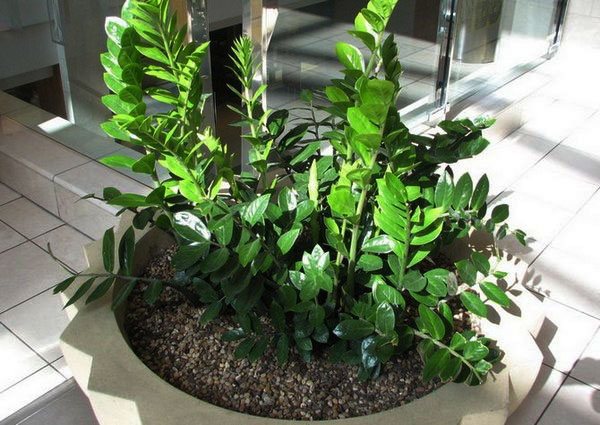

Dollar tree propagation methods
Reproduction of Zamioculcas is carried out in 3 ways:
The plant is rarely bred with seeds, since they do not ripen at home.
How to propagate a plant with a leaf
In order to propagate a flower using a leaf, do the following:
- take a sharp scalpel, treat it with a disinfectant solution, carefully cut off the leaf you like;
- then a piece of cotton wool and a tablet of activated carbon are placed on the bottom of the glass in order to exclude the process of decay. Now a leaf is lowered there so that its fourth part is in the water;
- After about 4 months, the leaf will give roots, and it can be planted in a pot in a permanent place of growth.
Some do not wait for the roots to appear, but stick a leaf a third directly into the ground. Then cover with a jar. From time to time, the jar is removed to moisten the soil.
Propagation using cuttings
Propagating a dollar tree by cuttings is also not difficult at all:
- cut off the petiole with leaves;
- divided into several parts so that each part has a leaf and a growth point;
- the separated parts are left for an hour and a half to dry the sections;
- then the prepared cuttings are stuck into the natural mineral vermiculite, watered and left for rooting;
- the roots will appear in a month. Then the cuttings are transplanted into separate pots.
Tuber propagation
A flower is propagated by a tuber if there are growth points on it. If there are any, then you can start dividing the tuber. The division is made so that there is a kidney on each part. The crushed particles are dried for about an hour, sprinkled with crushed charcoal. The parts should not be too small. Ready nodules are immediately planted in individual pots.
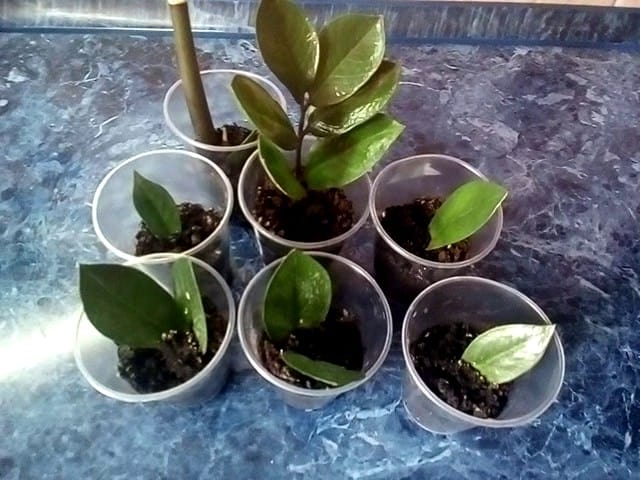

Photo of the reproduction of the dollar tree by leaves.
Possible errors
Is your scion dead or sick? There may be several reasons for this.
- The most common mistake that leads to disease and death of the plant is abundant watering.
- The "dollar tree" may simply lack lighting or heat.
- The division of the tuber should be done by a person who has at least minimal skills in this area. Otherwise, you can destroy the mother specimen and not get new plants.
In all other cases, problems with the reproduction of zamiokulkas by branches, leaves or cuttings usually do not arise.
Zamioculcas transplant
In the process of growth, the dollar tree must be transplanted into a more spacious container. How to make sure that the plant is damaged as little as possible? First you need to choose a suitable container.
Pot selection
It is best to choose a container from plastic, since when transplanting, you will have to cut the pot so as not to damage the root system of the plant. Choose a container so that it is slightly wider than the tuber itself. Expanded clay is placed at the bottom of the pot as drainage. Also, a little expanded clay can be poured into the ground for better air permeability.
When to transplant
A young plant, just bought or donated, needs to be transplanted. They do this not immediately, but a couple of weeks after purchasing a flower so that it can acclimatize to a new location.Up to five years, the tree requires annual replanting. As a rule, the transplant is carried out in the spring, in April-May.
This process allows the root system to develop favorably. After five years, the flower is transplanted as the roots grow. You can determine the transplant time by modifying the pot. If there is a deformation of the container from the overgrown root system, then Zamioculcas is ready for the transplantation process.
Transfer
This process is done as follows:
- cut the container and take out the plant. All manipulations are carried out very carefully so as not to damage the root system, otherwise Zamioculcas may wither;
- then the tree, together with a lump of earth, is placed in a new, more spacious pot, into which fresh soil is poured so that the tubers of the flower are on the surface;
- after transplanting, the plant is watered with water.
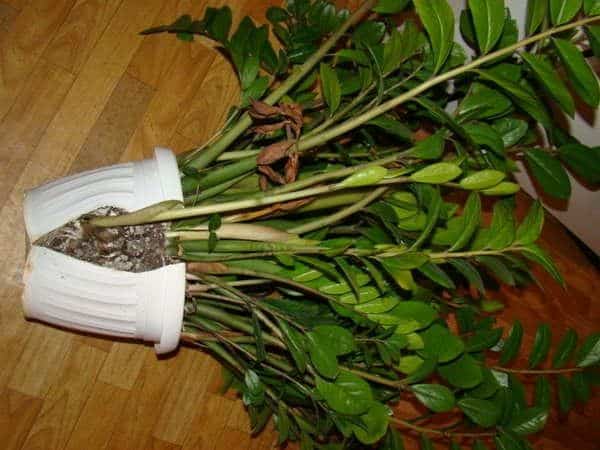

It is worth knowing that the juice of the dollar tree is toxic and can cause burns on the skin, therefore reproduction and transplantation are carried out exclusively with gloves.
Features of zamioculcas
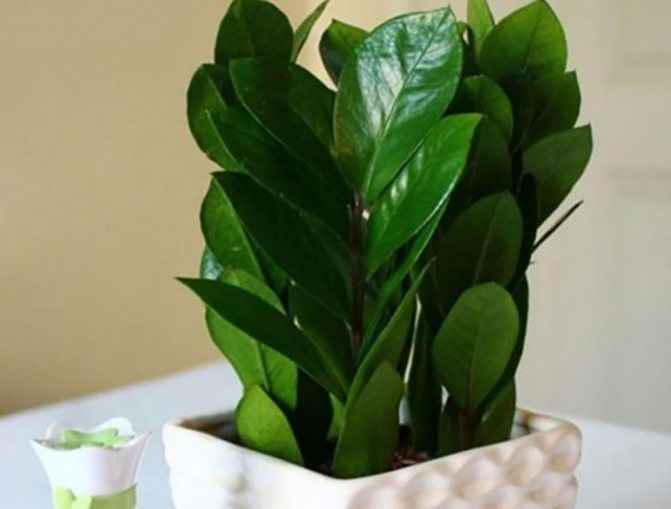

A feature of zamioculcas is that the leaves are the entire aerial part, and not each leaf separately, as many think. It consists of several plates located on the handle.
Unlike other tropicans living in apartment conditions, this plant is not whimsical - it grows well in heat, in a cold room - of course, you need to observe the measure. The only thing that the flower does not tolerate is excess watering in a cool room. The roots may begin to rot, it will be necessary to urgently save and transplant zamiokulkas.
The plant can survive on any soil, so it does not need to pick up something special. To create conditions for full-fledged growth, it is enough to place the flower on a lighted windowsill, but shade it from the sun's rays so that they do not damage the leaves.
Caution! Zamioculcas is very poisonous - alkaloids are contained in all its parts - aboveground and underground, so any manipulations are carried out with gloves.
How to care for a dollar tree
Zamioculcas is an unpretentious houseplant and it is not difficult to take care of it, you just have to follow the simple rules of care.
Where to put the flower
The plant loves good lighting and feels great under the rays of the sun, so it is best to put it on the southern window. Lack of light can adversely affect the flower - the leaves darken from poor lighting. The dollar tree is not picky about drafts. Thanks to this, in the summer, the container with the flower can be taken out into the open air.
What air temperature does he prefer
The air temperature in the room both in winter and in summer should not fall below +18 degrees. Lower rates can lead to the death of the flower.
Humidity
Zamioculcas can feel great in any humidity. There are no special instructions on this matter, except that once a month the leaves of a flower can be wiped with a damp cloth.
Watering and spraying
The dollar tree is drought-resistant, since there is always a supply of moisture in its tubers and fleshy stems, so it is not often watered. Do this when the soil is completely dry. Waterlogging should not be allowed, otherwise the pet may get sick and die. If desired, in the summer, the flower can sometimes be sprayed. In winter, spraying is stopped.
Top dressing
The plant responds well to feeding. They feed him twice a month. As a fertilizer, you can use humus and special formulations for cacti.
Soil selection
For the dollar tree, loose, breathable soil with a normal acidity index is used. Turf, leafy soil, sand and peat are usually added to the soil, as well as a little sphagnum. You can buy a ready-made mixture for cacti.
Pruning a dollar tree
With the help of pruning, the crown of the flower is formed.It is worth pruning the plant in spring and early summer, when intensive leaf growth occurs. If you cut off the top edges of the leaves, the tree will take on the shape of a ball, which will give it a greater effect.
Pest control
The plant can be harmed by pests such as spider mites and scale insects. Signs - yellowing and falling leaves, the formation of dark spots on them. In order to prevent this attack, the flower is sprayed with pest preparations.


Also, the tree can be affected by parasites, which include aphids. If the leaves curl into tubes and lose their color, then an aphid attack is obvious. Kinmiks, Iskra, Fitoverm, Decis, Karate and others will help to protect the flower from the pest. From folk remedies, a solution of garlic or wood ash with laundry soap is effective (0.5 kg of ash and 50 g of soap are taken for 10 liters).
Watering mode
In fact, growing young shoots of the "dollar tree" is not difficult at all. To do this, it is enough to provide the plant with food, moderate watering and warmth.
When wetting the soil, you should follow a few simple rules.
- During active growth, young specimens should be watered only as the soil dries out. In this case, the pallet must always be empty. In winter, water the plant only after the soil has completely dried out.
- Periodically you need to spray the green mass of the "dollar tree".
- If the leaves of zamiokulkas began to crumble due to a prolonged drought, do not despair, because you can reanimate the plant. To do this, just water the soil well, and soon the flower will come to life again.
- Occasionally wipe the zamiokulkas foliage with a damp sponge. So you will not only give it moisture, but also give it a neat appearance.
General information
Until the end of the 20th century, zamioculcas was practically not known as an indoor culture. But with the beginning of massive sales at Dutch flower auctions in 1996, it gained worldwide popularity among both amateurs and professionals of indoor floriculture and gardening specialists and is still popular, despite the fact that it is not cheap.
By 2007, the miniature zamioculcas was cultivated, outwardly it does not differ from the usual one, only the bush is more compact (it grows up to 60 cm) and the leaves, respectively, are smaller.
Types and varieties of Zamioculcas
There is only one type of plant - Zamioculcas Zamiifolia. Its homeland is considered the eastern and southeastern African mountain plateaus with a tropical climate. It was there that it was discovered in 1828. There are many varieties of this plant. The most unusual of them Black Zamioculcas Blak
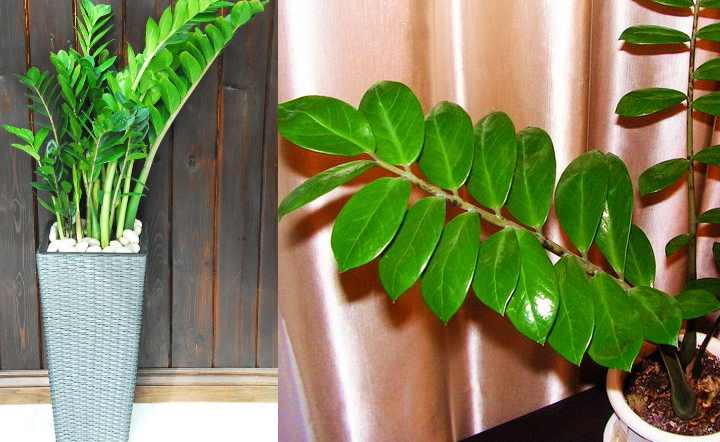

The plant has almost black leaves and cuttings in adulthood. Otherwise, it is completely similar to zamioculcas zamifolia. The same fleshy leaves pointed at the tips, fixed symmetrically on both sides on a common cutting. The young bush has lettuce-colored leaves. As they grow older, they begin to darken. At the same time, their color is completely unaffected by the lighting in the room. This "tree" looks very impressive. Therefore, it will perfectly decorate any room.
SIGNS
- According to existing beliefs, Zamioculcas has an energy that can attract wealth and prosperity to the room where it is located. Many people believe that the Dollar Tree will help them get rich. Those who are at least a little familiar with the teachings of feng shui know that the wealth sector is located in the southeastern part of the premises. If you believe in it, then the place of Zamioculkasu is there.
- It is clear that the healthier and more beautiful the plant is, the richer you will be. As soon as a new leaf appears on Zamioculkas, you will definitely have something somewhere to arrive.
- If the leaves of the Dollar Tree began to turn yellow and fall off, something is wrong with finances.Perhaps the flower warns you of an impending sharp deterioration in your financial situation, or perhaps you just haven't watered the flower for a long time.
- It is believed that if the Dollar tree blooms, then its mistress will soon get married. But Zamioculcas blooms at home very rarely. Therefore, it is also called the "Flower of celibacy." It is better not to have such a flower for a girl who wants to get married. However, ladies who do not believe in omens have been growing this beautiful and unpretentious flower for many years and do not notice any negative influences on their personal life.
Seed propagation
Do not expect to find seeds - they simply do not exist, since this plant blooms extremely rarely and without them (maybe they are in Africa, but not likely). If you're in luck:
- Sow seeds in a container with soil for violets or cacti with a distance of 2-3 cm between them. The soil should be moist, not wet.
- Cover with foil and open for airing once a day.
- Keep an eye on the moisture content of the ground surface, do not allow the appearance of a dry crust, moisten with water from a spray bottle.
- Plant when the first 2 true leaves appear (they grow after the cotyledons).
You will have to wait for seedlings for a long time, at least two months. First, the plant needs to form a tuber, from which the sprout will hatch later.
Zamiokulkas seeds ripen extremely rarely
How to reanimate zamioculcas
If the plant has rotted tuber.
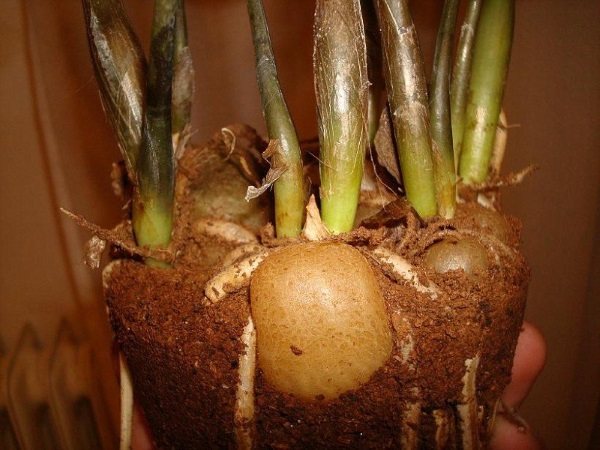

In this case, we take out all that remains of the flower and clean it to a healthy place. We grow a new flower from the remains. If there is at least some kind of root, we plant it immediately in a new soil, if there are only leaves left, we put them in water to build up roots.
If leaves curl
Deformation of the leaves indicates that the flower is affected by harmful insects. In this case, the zamioculcas must be carefully examined and, having found them, get rid of the pests with a suitable preparation.
If the leaves of the plant are frostbitten during transportation
This is the easiest case of what a zamiokulkas can suffer from. Since the root system in this case is completely healthy, the frostbitten leaves are cut off at the root, and after a while the roots begin to give out new healthy leaves.
Plant varieties
The main variety is zamioculcas zamielistny, which has green leaf plates. On sale you can also find variegated varieties, which have white spots and veins on a green background.
There are also rare varieties, for example, black zimioculcas. In the store, they practically do not exist. If you buy, you will have to fork out, because the main indicator for pricing is the height of the plant, as it develops slowly.
Variegated zamioculcas
It is considered an outlandish species, since it is rarely found even in natural conditions. It blooms very rarely - to see the variegated form of a plant blooming is a real miracle.
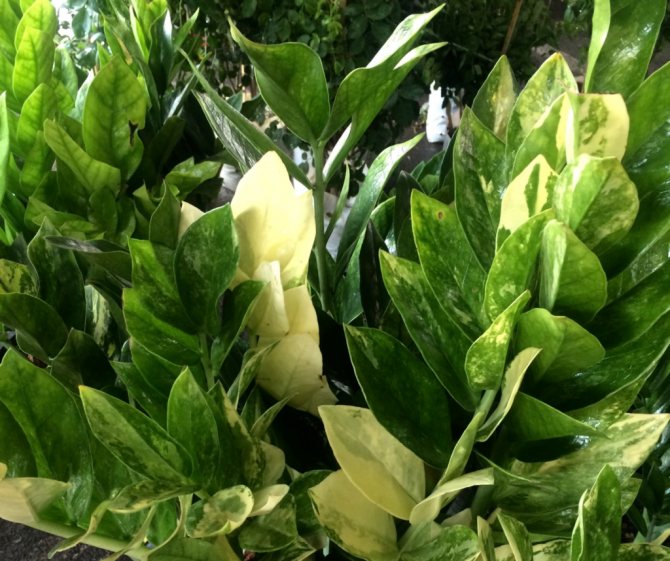

Lanceolate
The leaf plates of this type are elongated. The breeders did a good job on it, so it became available for lovers of indoor succulents. In the wild, the plant sheds its leaves during a prolonged drought - while the tubers retain moisture and survive.
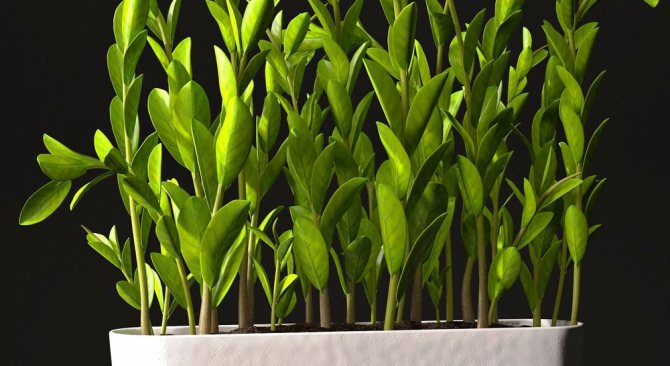

Motley
Lemon-colored spots on dark green leaves. It can be confused with a variegated form, but they are two different varieties.
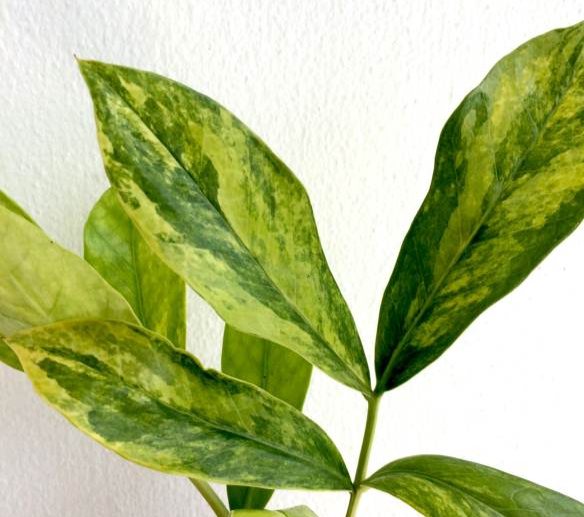

Dark purple
Zamioculcas black Raven is also called purple for dark purple with a red tint, almost black color of leaf plates and stems. A native plant from Korea, small in height.
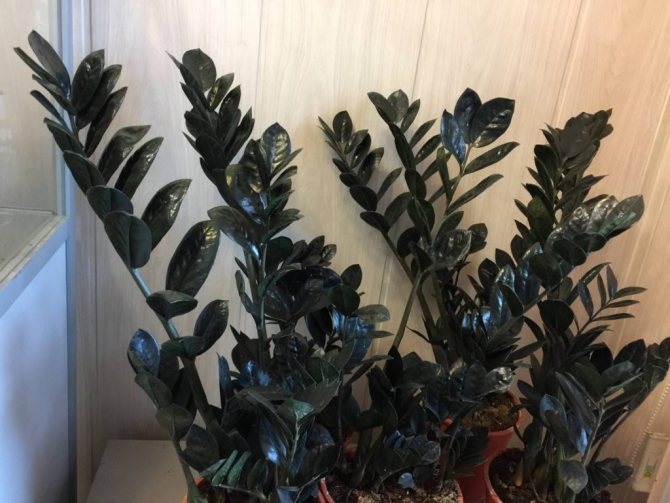

Boivin
Botanists transferred Boivin's gonatopus to a different species, but due to the shape of the cob and the similarity of flowering, flower growers continue to attribute it to the Zamiokulkas variety.
Zenzi
Zamioculcas Zenzi is a selective dwarf form, up to 60 cm high. Differs in thicker stems and shortened leaves.
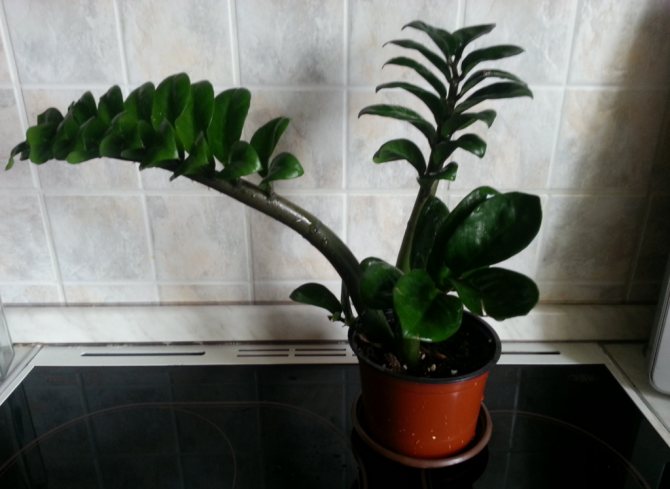

Tips & Tricks
Experienced growers know that zamioculcas can multiply in several ways, but if the mother plant is large, then it is best to use tuberous propagation. For those florists who are just going to purchase a tropical plant for indoor cultivation, the method of propagation by leaf blades is optimal. Important to remember, that as a substrate for rooting, not only water can be used, but also soil or medium-grained sand treated with fungicides.
How to grow zamioculcas from a leaf
How realistic is it to grow this plant yourself at home and what is needed for this?
Zamioculcas is a plant of the Aroid family, native to tropical Africa. It does not grow very quickly, but in general it is unpretentious: even an amateur florist will be able to care for it. People have already christened zamiokulkas “dollar tree” for some resemblance to “money tree” (bastard). Adult specimens look majestic and impressive, but they also ask for a rather big price. But you can grow a flower yourself. You just need to be patient, time and get a few leaves of zamiokulkas.


Soil and planting
Cut the sheet obliquely, sprinkle the cut area with crushed charcoal or activated charcoal and leave to dry for a few hours. Capacity disposable cups, seedling pots can serve for rooting. Lay out the bottom with pieces of foam, expanded clay or pebbles - this will drainage.
Next, pour into the pot land - best of all 2 hours of peat and 1 hour of perlite. You can also use an earthy succulent mixture or mix soil with sand. Moisten the substrate and immerse the sheet in it to a depth of 1.5-2 cm. Press down the substrate a little so that it fits snugly against the sheet.
The leafy cutting will take root in about 1-1.5 months. Good lighting, adherence to the temperature regime (not lower than 21-22 ° C), moderate watering and feeding will help in this. Water cutting with a spray bottle - stagnant moisture can cause leaf decay. In the summer, the leaves are cover with a glass jarto maintain moisture.
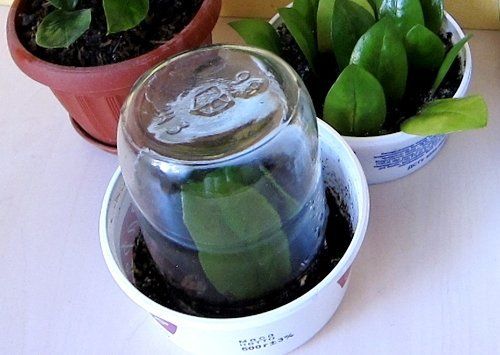

Periodically water the young zamioculcas with biostimulants (they can be purchased in flower shops), and if you have aloe at home, add 2-3 drops of plant juice to the water for irrigation. Aloe juice strengthens, disinfects and stimulates growth.
Typically, November leaves take 2 times longer to root than those planted in June.
Tuber formation
After a month, you can check the leaves - by this time small tubers may already have formed, and some even have roots. Let them grow a little more and plant them in a pot. Best of all - in one, so that the bush in the future will be more magnificent. The capacity for a flower should not be large, otherwise the root system will begin to develop intensively to the detriment of the growth of the plant itself.
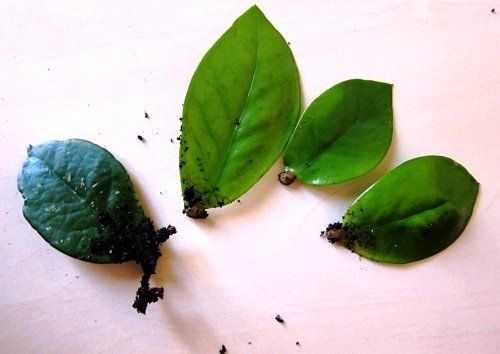

Waiting for the shoots
Some leaves with mature tubers may dry out. Don't worry, they sacrificed themselves for a new life. However, it is clear that cuttings that remain green develop better, and will give the first leaves faster.
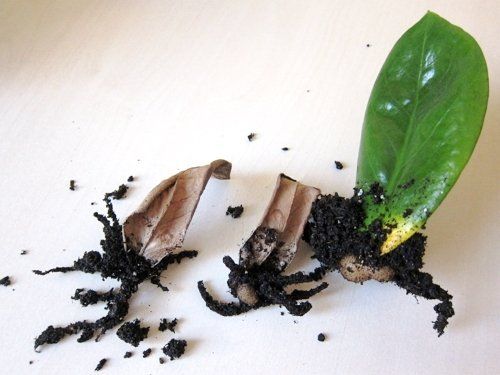

The appearance of shoots and rules of care
The long-awaited first branch will be a real holiday for you! In order for the flower to please for many years, remember the simple rules of care: zamioculcas requires moderate watering, which should be minimized in winter. Likes good lighting, but prefers diffused light direct sunlight, sensitive to drafts, cold and dampness. From spring to autumn, during the period of growth, it needs feeding.
Now that you have your own flower, let it grow stronger, and you can propagate it not only by leaves and cuttings, but also by tubers.
Pests
Pest parasites on zamioculcas appear quite rarely, because they do not like its thick peel.
Despite the fact that the leaves of zamiokulkas are covered with natural wax, which is designed to protect the plant from pests, aphids, scale insects and other insects do not allow it to live peacefully.
| Name of the pest | Harm done | Description of the pest and method of detection | Method of struggle |
| Aphid | It sucks the juice out of the leaves, after which the leaves become curled and dry. | The insect is black, gray or green. Usually located on the back of the leaf, closer to the tops of the shoots. | Special ready-made preparations or soap solution with the addition of 1 g of nicotine sulfate per 1 liter of liquid. Also, the soap solution is mixed with wood resin. |
| Shield | Covers foliage with dark spots. | Looks like plaque on sheets. | Soap-tobacco solution with kerosene or with a small amount of denatured alcohol. |
| Spider mite | Envelopes the underside of the leaf with a cobweb. | Small red spider. | Wash and spray the leaves with water or a mild tobacco solution. |
| Thrips | On the leaves, areas of lesion are formed of a silvery color, the stems are bent, traces of excrement are visible | Oblong insect with wings | Repeated treatment with insecticides (actellik, intavir, karbofos, etc.) |
| Mealybugs | Stopping growth, change and loss of leaves | Insect size 3.5-5 mm | At the initial stage, remove with a sponge soaked in soap or alcohol solution. At a later date, the use of pesticides is necessary. |
Diseases
Zamioculcas is a strong and hardy flower, but even it may develop diseases that need to be fought. This plant is quite resistant to most diseases. Diseases affect zamiokulkas mainly with mistakes of the owner-grower.
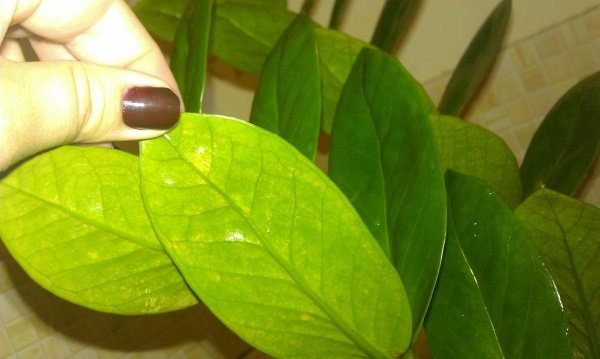

| Problem | Cause | Decision |
| Root rot | Excessive watering | Stop watering, free the plant from the soil, remove the rotten roots, then change the soil to dry. |
| Yellow leaves | Excessive watering, or its absence, or a decrease in temperature to unacceptable values. | Depending on the reason: stop watering, check for rotten roots; resume watering; increase the air temperature to optimal. |
| Dark spots | Low air temperature or keeping the flower in a draft, too abundant watering | Adjust the heat and humidity conditions, remove the flower from the draft. |
| The leaves turn pale, the plant stretches and grows thin | Insufficient lighting | Move the flower closer to the sun or provide artificial lighting |
Now you are armed with useful knowledge on the maintenance and cultivation of the dollar tree - zamioculcas at home and you can safely apply it in practice.
The plant arrived from hot Africa will undoubtedly decorate your interior at any time of the year. We wish you and him longevity and health.
Varieties
Most often, in the collections of florists, you can find zamiokulkas zamielistny. So he was named by botanists for the external resemblance to Zamia - an American evergreen. The leaves of this variety are rich green, uniform, glossy. In large adult plants, the leaf may have dark green-purple spots closer to the base.
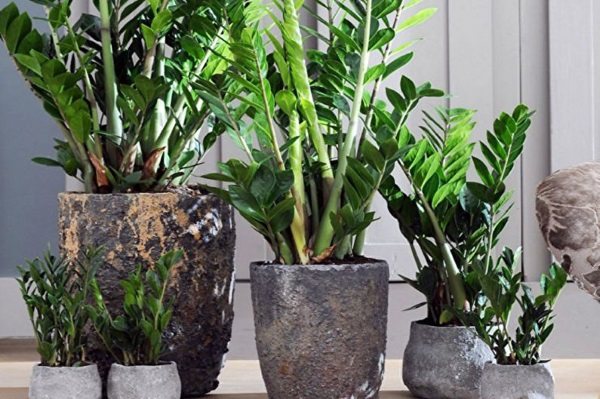

A much rarer, and therefore much more expensive, species is variegated zamioculcas. The leaves of this plant have a heterogeneous color, transitions from intense green to very light and even white. This effect is due to the presence of mutated cells that are unable to synthesize chlorophyll, which makes them discolored. The word "variegated" in translation from English means "variegated", "multi-colored", therefore, these types of plants are often called "variegated".
Brief information
East Africa is the birthplace of Zamiokulkas. It was brought to Europe from Zanzibar and Madagascar. It belongs to the aroid family. It attracts attention with its luxurious leaves.Its difference from other indoor plants is that the leaf is a whole shoot growing from an underground tuber. On each of its leaves, up to 10 pairs of small leaves grow.
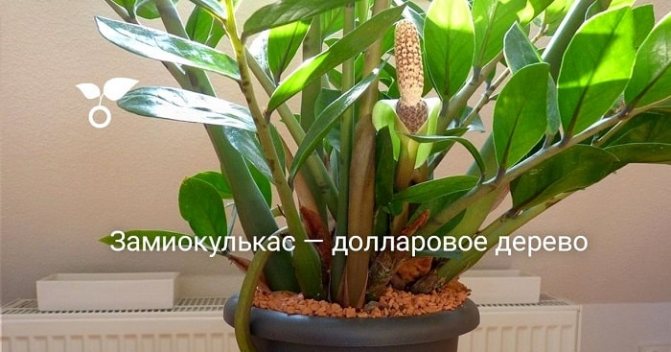

The appearance of zamiokulkas
There are many beliefs about him. The most common:
- It brings good luck to the house and contributes to the growth of the financial condition of the owners. Therefore, it has another name - the dollar tree.
- Zamioculcas is also called a female tree. They say that with his appearance in the house, the girl finds her love and prosperity. And if it bloomed, which happens infrequently, you can start preparing for the wedding.
It's important to know! The plant sap contains toxic substances that can cause an allergic reaction: the appearance of redness, burning, itching. Therefore, all work related to transplanting, cutting leaves, dividing tubers should be performed with gloves.
Fundamental rules
When propagating a flower culture, a number of mandatory rules are observed:
- all manipulations are carried out with a sharp instrument that has been disinfected so as not to provoke the spread of infectious diseases;
- when working, use gloves to protect the skin from the harmful effects of the poisonous milky juice of a succulent;
- when dividing a bush, it is worth adhering to accuracy so as not to lose either the new or the parent plant;
- for planting, use a suitable substrate with the inclusion of disintegrants (charcoal, crushed brick, perlite or vermiculite with a fraction of up to 7% of the total volume) and be sure to lay out the drainage with a layer of 3 cm or more.
What to do with zamiokulkas after purchase
To preserve the decorative appearance of zamiokulkas, you need to properly care for it from the moment of purchase. Despite the temptation to immediately transplant the plant into a beautiful flowerpot, do not rush, but let the flower get used to the new conditions. By the way, it is better to buy a plant during the warm season so that it does not freeze on the way home.
When the plant settles in the new room, after about 2-4 weeks, you can carefully transfer it into the pot along with the old earthen clod, and fill the gaps with fresh soil. This will reduce the stress of the procedure.
Choose a transfer pot according to the size of the plant. The diameter of the new container should be 3-4 cm larger than that of the previous one. Pottery and clay pots work well. It is better not to use plastic ones, because the roots of the plant can break through them. The ideal shape of the pot is narrowed downwards. There must be holes in the container for water drainage.
Some growers, on the contrary, prefer plastic containers, because it is difficult to extract a plant from ceramic in the future. If you also love plastic pots, feel free to use them for handling. Just make sure that the plant does not grow very much, and carry out a new transshipment in time.
To make the dollar tree recover faster after transplanting, adhere to the following rules:
- use light and fertile soil;
- be sure to drain using expanded clay, clay shards or broken brick;
- do not completely bury the roots into the soil, they should protrude about 1 cm above the soil surface;
- do not shake off the soil from the earthen clod.
Always wear gloves while working, as Zamiokulkas juice is poisonous.
You cannot water the plant immediately after the procedure, otherwise it will die. Do this after about 7-10 days, when the zamioculcas adapts to the new pot. The first watering should completely wet the earthen lump. Drain the water drained into the pan. Water the flower next time when the soil is dry.
How to properly plant an unpretentious plant - Zamioculcas ("Dollar tree")?
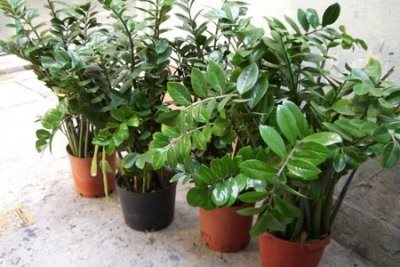

Zamioculcas (lat.Zamiocúlcas) or as the people call it Dollar palm - an ornamental plant, the home of which is Africa.
Zamioculcas is popular with flower growers due to its unpretentiousness.
With good care and comfortable living conditions, it can reach an impressive size. The flower is a lush bush with beautiful dark green glossy leaves and rightfully serves as a decoration for any room.
Zamiocúlcas can be purchased at almost any flower shop. Its price at the present time is rather big, so the flower can be grown at home on your own.
Zamioculcas propagates easily - by cuttings, adult leaves and even leaflets. If in your environment there are experienced growers who grow this plant, they will be happy to share planting material with you.
There is little to do - to plant the flower correctly so that it takes root well and does not die. The article is devoted to how to plant a Dollar Tree.
Tuber propagation
Reproduction of zamiokulkas by tubers, or rather by dividing them, is practiced in indoor floriculture conditions quite often. This method of obtaining a new plant is used in the process of planned transplantation of an ornamental culture. It is necessary to divide the tuber carefully, minimally injuring the plant.... The separated parts must be slightly air-dried, and the sections must be processed with crushed charcoal or activated carbon.
Planting after dividing the underground part of the plant into separate fragments with a bud must be carried out in a previously prepared soil. Planting material should be in flower pots that have drainage holes and are filled with a light, sufficiently nutritious soil mixture. You can use universal primers with the addition of a small amount of baking powder-vermiculite. The first watering of a young plant is carried out no earlier than three days later. Irrigation measures should be in the form of spraying the soil with settled water at room temperature.
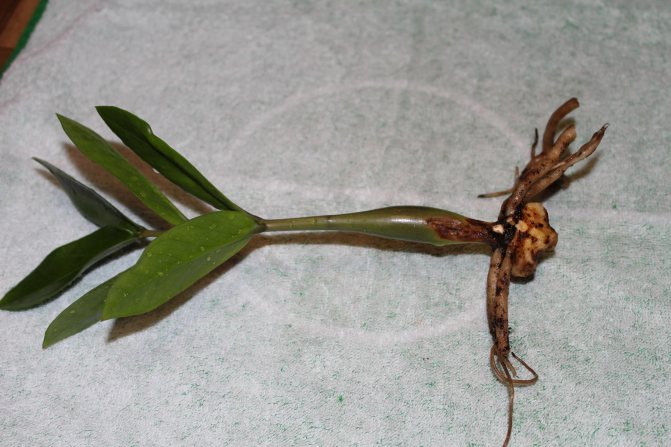

Branch propagation
"Celibacy flower" or zamioculcas reproduces very well with a standard branch when rooting in the sand. A branch from a botanical point of view is a pinnate leaf of a zamiokulkas, starting, like a frond of a fern, from the base of an ornamental culture. For planting, it is recommended to use a twig or vayu, the lower part of which is half stiff, and the apical part has a juicy green coloration.
Read also: World's Hardiest Horses
If water is used for rooting, then it is mandatory to add an activated carbon tablet, which will reduce the risk of decay and death of the planting material. It should be noted that branch propagation allows a more developed tuber to form, and the resulting indoor flowers look more mature. Nevertheless, while young, newly formed shoots "catch up" in growth with the maternal aboveground part, the decorativeness of the culture is reduced.
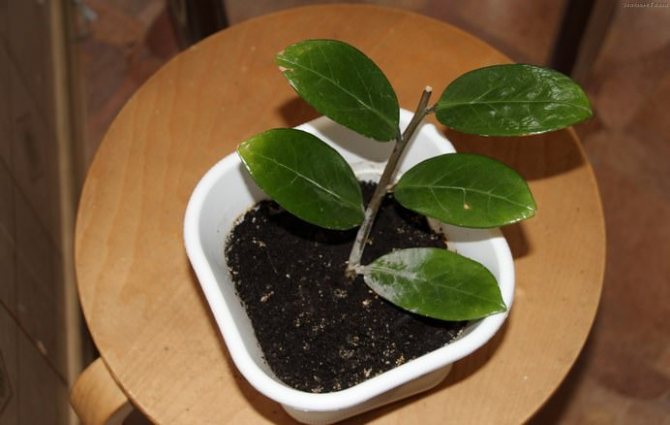

Diseases and pests of zamiokulkas
Zamioculcas is a very hardy plant, so diseases and pests rarely affect it. Most often, the cause of the problem is improper agricultural practices (for example, if you watered the plant too often) or unfavorable external factors (if the dollar tree spent the whole summer in the garden and became infected with pests from other crops).
If you notice changes in the appearance of a flower in time, it can still be saved. Try to regularly inspect the leaves of the zamiokulkas, they will tell you if something went wrong. The most common problem is the yellowing of the leaves of the dollar tree. We have collected the reasons and ways of solving it in one table.
| Why do the leaves of zamioculcas turn yellow | What to do |
| Waterlogging of the ground (leaves turn yellow and then brown, roots soften) | Transplant the plant to fresh soil urgently. Pre-remove all rotten parts and process the sections with crushed charcoal or a weak solution of potassium permanganate |
| Overmoistening of the air | Stop spraying, ventilate the room regularly, or move the flower to another room. |
| Temperature changes (root shoots also rot and dry out) | Carry out the treatment with Kornevin. If the room temperature is low - protect the plant from drafts, high - place a container of water next to the pot |
| Lack of feeding | Gradually introduce top dressing with ready-made preparations, for example, Agricola fertilizer. Just do not exceed the dosage, otherwise the condition of the weakened plant may worsen. |
| No clipping | Cut off overgrown side shoots, remove yellow leaves. Transplanting the plant into a larger pot and regular feeding will also help. |
The lower leaves of an adult zamiokulkas turn yellow and die over time. This is a natural aging process, so there is no need to worry.
One of the reasons for the yellowing of the leaves can be the presence of pests: aphids, spider mites, mealybugs or scale insects.
If you find pests on zamiokulkas, immediately isolate it from other indoor plants to avoid a massive epidemic.
When growing zamiokulkas, you may encounter other problems. For example, spots on the leaves indicate that the plant is overcooled in a draft or received a sunburn. It is enough to remove aggressive environmental factors, and Zamiokulkas will feel better.
If the stem begins to rot, the plant is overfilled and its tubers, most likely, have suffered very badly. In this case, it will have to be thrown out, but you can still try to root and grow a new zamioculcas with living leaves from the top.
If the zamioculcas has lost its aerial part, do not rush to throw it away. Inspect the tuber, and if it looks good, soak it in a mild potassium permanganate solution and plant in fresh soil. The plant will surely survive and start new shoots. The main thing is not to water it too often and protect it from drafts.
Frequent problems when growing zamioculcus
The biggest trouble that growers face when propagating a dollar tree is rotting cuttings, roots and young nodules. The main reason is waterlogging of the soil. Newbies freak out when they see a yellowed stalk that has been planted for rooting. In fact, there is nothing wrong with that. Nutrients from the leaf are transferred to the newly formed tuber. Gradually, this stalk turns brown and dies off. The next problem is that planted cuttings do not show signs of rooting and growth for a long time. This phenomenon is observed in low light conditions. Consider the reasons for the suspension of the growth of the adult zamiokulkas:
- Incorrectly selected pot. It should be tight, only 1-1.5 cm larger than the root system with a tuber. It is enough to transplant the flower into a smaller container, and the problem will be solved.
- Deepening the tuber. When landing, it should be turned so that it is close to the surface.
- The growth of the dollar tree slows down with a lack of nitrogen, poor lighting.
- Improper watering. The plant is often not watered. It tolerates drought better than excessive moisture.
- Rotting tubers damaged by transplanting or abundant watering. Proposed rescue measures are to cut off rotten parts from the tuber, treat in a manganese solution, sprinkle with activated carbon powder. Plant and maintain with poor watering.
- Diseases and pests also slow growth. Specific measures are required to combat them.
- In the period from October to February, zamioculcas is in a dormant period. Don't worry. This is a natural process.
We draw conclusions. Patience is required for those wishing to propagate zamioculcas in any way. The necessary period for rooting is 2-6 months. The very process of caring for a plant is simple. It takes time for a luxurious handsome man to appear in the house.
Reproduction by dividing the uterine tuber
Reproduction of zamiokulkas by dividing the uterine tuber is carried out in the spring, when it is time to transplant the plant into a more spacious flowerpot. The tuber is easily divided into parts. You do not need to cut, otherwise you can ruin your pet... You need to make sure that at least one growth point remains on each branch.
In no case should you cut the roots of zamiokulkas
- After dividing the tuber into the required number of future plants, dry the damaged areas by sprinkling them with charcoal or crushed activated carbon.
- Let them air for 2 hours.
- After that, plant it in a permanent flowerpot. Choose a container that is at least 20 cm in diameter and 25 cm in height. Pour expanded clay or small stones on the bottom. Styrofoam balls or eggshells can also be used as drainage. Do not be alarmed that it will alkalize the soil, the increased acidity is harmful to zamiokulkas. The drainage layer must be at least 1 cm. Use a special soil mixture for cacti or any other light poor soil as soil.
- Cover the pot with a jar to create the required microclimate and place them on the windowsill. The plant does not need additional lighting.
- Monitor the moisture and water periodically with a sprayer so that not only the roots but also the leaves receive moisture.
- After new leaves appear, remove the jar.
Liming will also help to reduce the acidity of the soil, read about this: https://enn.imadeself.com/ozelenenie/izvestkovanie-pochvy.html
A full-grown adult plant can be admired in a year.
How to feed zamiokulkas
The dollar tree quickly picks up nutrients from the soil and will gratefully respond to regular feeding. During the growth period, from April to September, 1-2 procedures per month are enough. There is no need to fertilize the plant from October to March. The basic rule of feeding is the same as when watering: less is better than more.
Use ready-made store preparations, for example, universal or for cacti and succulents. Half the concentration of the solution is enough for Zamioculcas. Water at the root. Also, once a month, you can spray the flower with a urea solution (1 g per 1 liter of water).
If you've just transplanted a young plant, don't feed it until new leaves appear.
We propagate zamioculcas: methods for home growers
Zamioculcas is often called the "dollar tree". It is believed that this plant, which came to our homes from exotic Africa, brings material prosperity to its owner. Another name for zamiokulkas is "female happiness". There is a popular belief that its owner miraculously becomes desirable for the opposite sex and finds happiness in her personal life. Agree, a good reason to have your own green artifact at home! Of course, you can buy a mascot plant in the store, but it is much more interesting to grow happiness with your own hands. Moreover, they say that in this case the effect of the acquisition will be greater.


